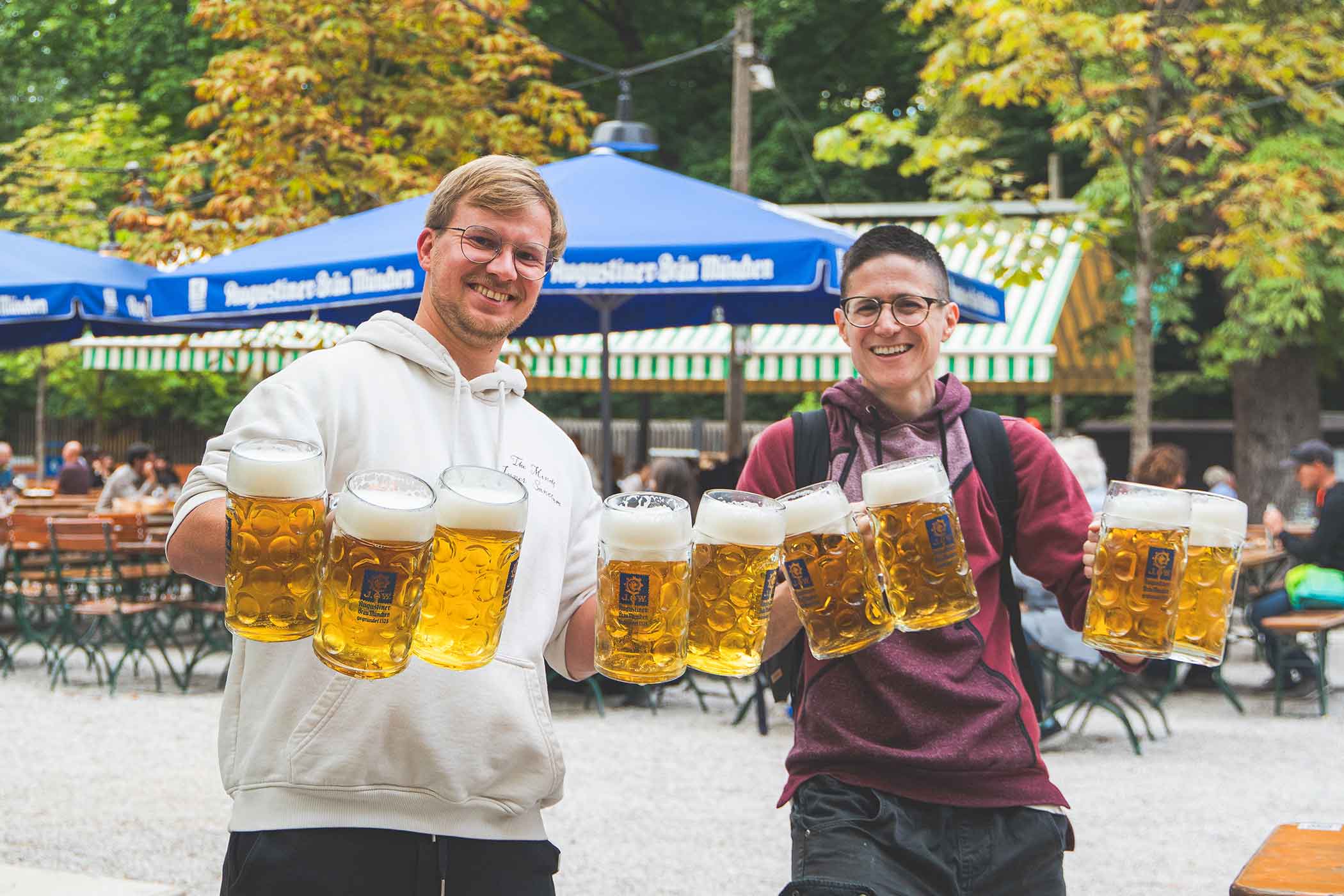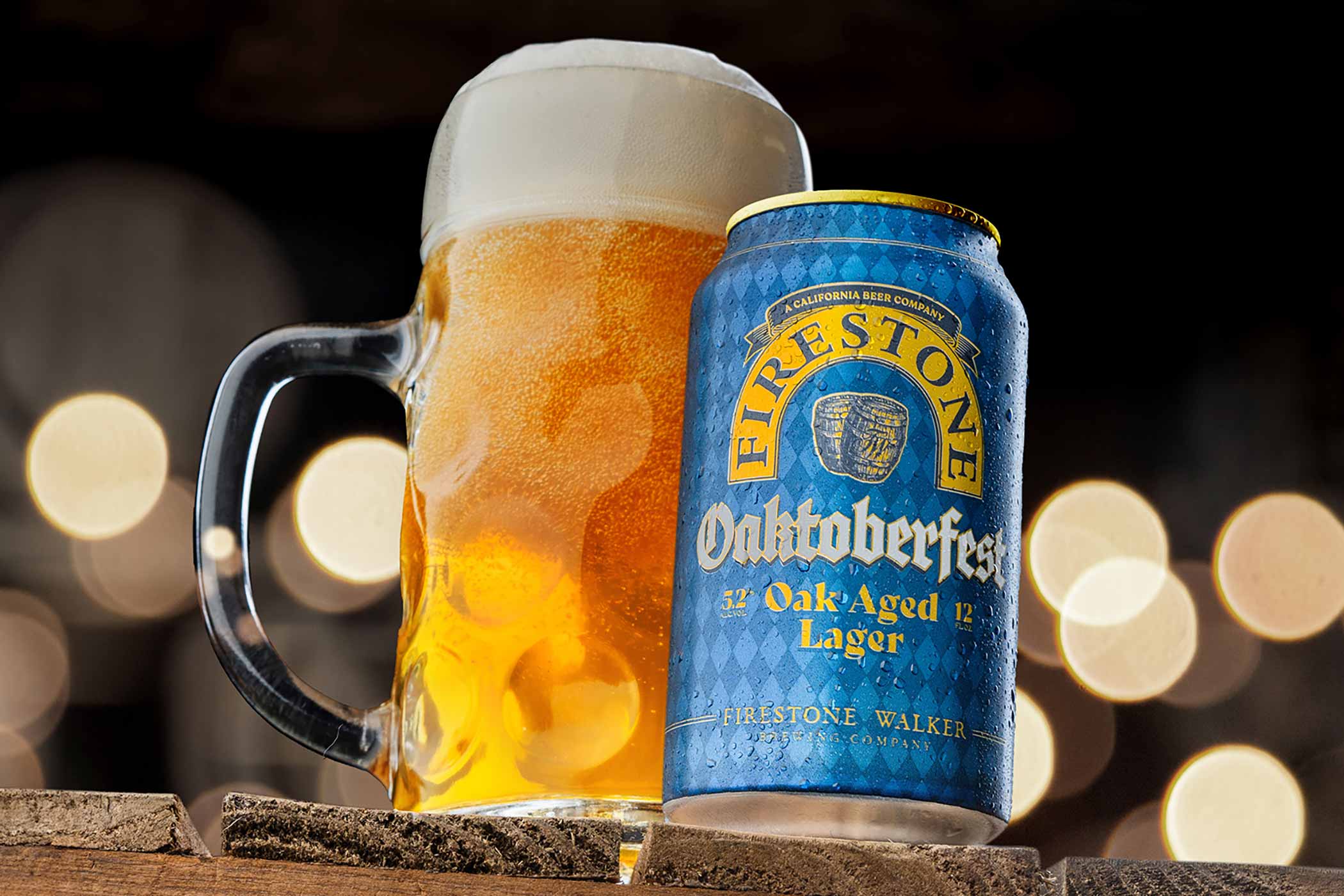Shop
How to Spend Five Days in Bavaria and Franconia
Prost!
Like This, Read That
Nestled into Germany’s southeastern quadrant, Bavaria and Franconia are the country’s drinking soul—and both beat to the rhythm of clinking steins, sizzling sausages, and centuries-old brewing tradition. This is where beer isn’t just a drink; it’s a way of life. Over five unforgettable days, we journeyed through these storied regions with Trip’s Beer Trips, tracing a frothy path from bustling biergartens in Munich to smoky lagers in Bamberg, from hopping countryside cellars to medieval castle courtyards.
Our goal? To experience Germany’s beer culture the way locals do—slowly, joyfully, and with an empty stomach (and soul) ready to be filled. Whether it was raising a maß (pronounced mas, this is the German word for a one-liter beer mug) of golden Helles beneath leafy trees at Augustiner-Keller, discovering the underworld of Entla’s-Keller in Erlangen, or learning the difference between rotbier and rauchbier firsthand, each stop offered something more than just a pint: We found a story.
So, whether you’re planning your own pilgrimage through Bavaria and Franconia or simply looking for a vicarious buzz, this guide has you covered. Follow our footsteps through Munich’s iconic breweries, Franconia’s hidden beer cellars, and Bamberg’s smoky heartland—or craft your own adventure with Trip’s Beer Trips.
Prost! To five days of discovery, good company, and some of the best beers on Earth.
Interested in hearing when we curate our next trip? Sign up here to get updates first.
A Few Drinking and Eating Etiquette Reminders
As we learned on our trip, there are a few cultural rules you should keep in mind when eating and drinking your way through Germany.
First, as our guide, Tobias Kerschbaumer, explained to us, whatever you order, you should eat. Portions in Germany can be quite hearty, so plan to share dishes. It is considered rude to waste food and leave leftovers. You can certainly ask for a box to go if that’s an option, but to simply send food back uneaten is not respectful.
When drinking, you cheers by looking the person you’re toasting in the eye. Also, never reach over someone else’s toast to start your own. Either go under or wait for those folks to finish.
Additionally, note that many establishments in Munich are closed on Sundays.
How Hop Culture Spent Five Days in Bavaria and Franconia
Day One: Munich
Whet your whistle in Bavaria’s capital.
Biergarten Viktualienmarkt
Viktualienmarkt 9, 80331 München, Germany
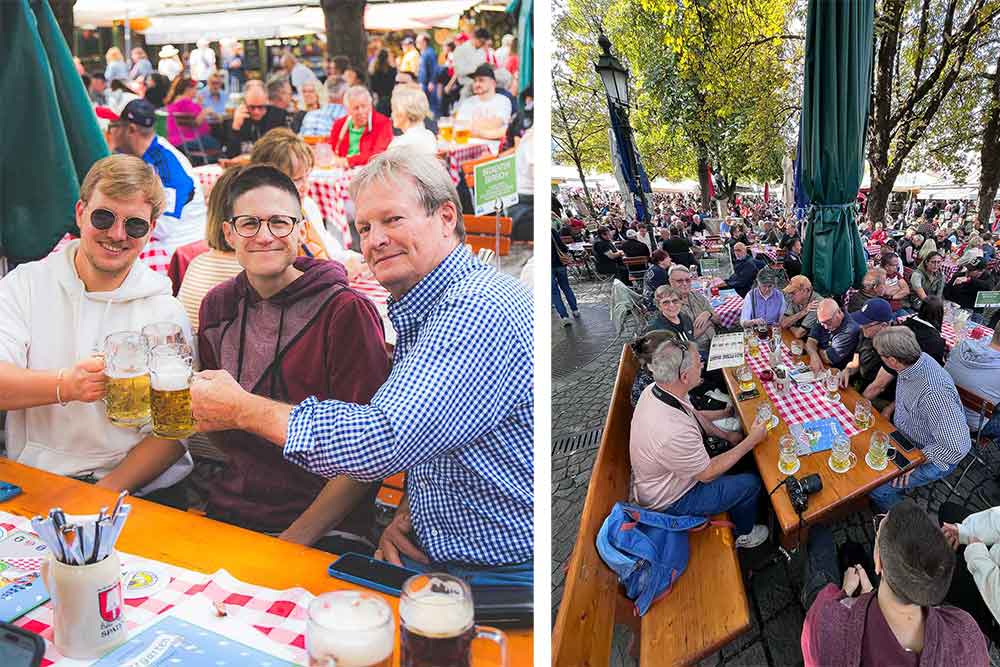
Photography courtesy of Magic Muncie, Social Media Manager, Hop Culture and Untappd
Located right by the Marienplatz, the bustling central hub of Munich, Biergarten Viktualienmarkt is a large, beautiful beer garden serving beer from classic Munich breweries.
Rotating beers from one of the six original breweries—Augustiner, Hacker-Pschorr, Hofbräu, Löwenbräu, Paulaner, and Spaten—this low-key outdoor beer hall is the perfect place to start your Bavarian adventures.
On the day we visited, they featured Augustiner, meaning half-liters of Augustiner Lagerbier Helles quickly crowded our table.
A return visit several days later saw Paulaner as the headliner with the tables still packed and overflowing with maß, regulation-sized beer-drinking mugs.
Climb St. Peter’s Church
Peterspl. 1, 80331 München, Germany
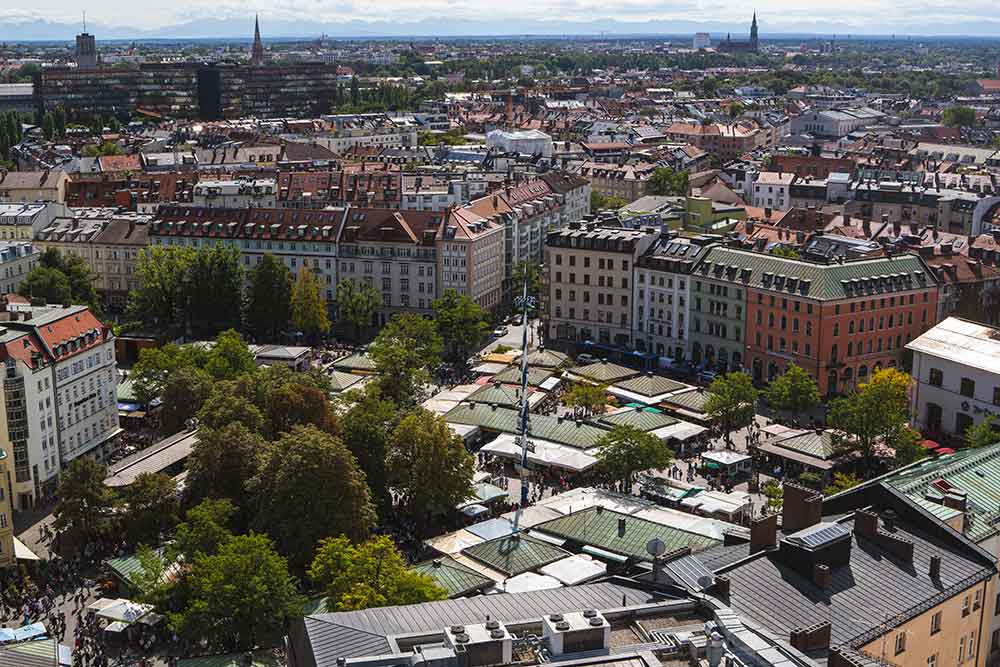
Photography courtesy of Magic Muncie, Social Media Manager, Hop Culture and Untappd
It’s a touristy thing to do, and you’ll probably have to wait in line, but climbing the steep, narrow steps up St. Peter’s Church offers you amazing views of Munich. We did it after one maß; we probably don’t recommend doing it after two (or if you’re claustrophobic!).
Hofbräuhaus München
Platzl 9, 80331 München, Germany
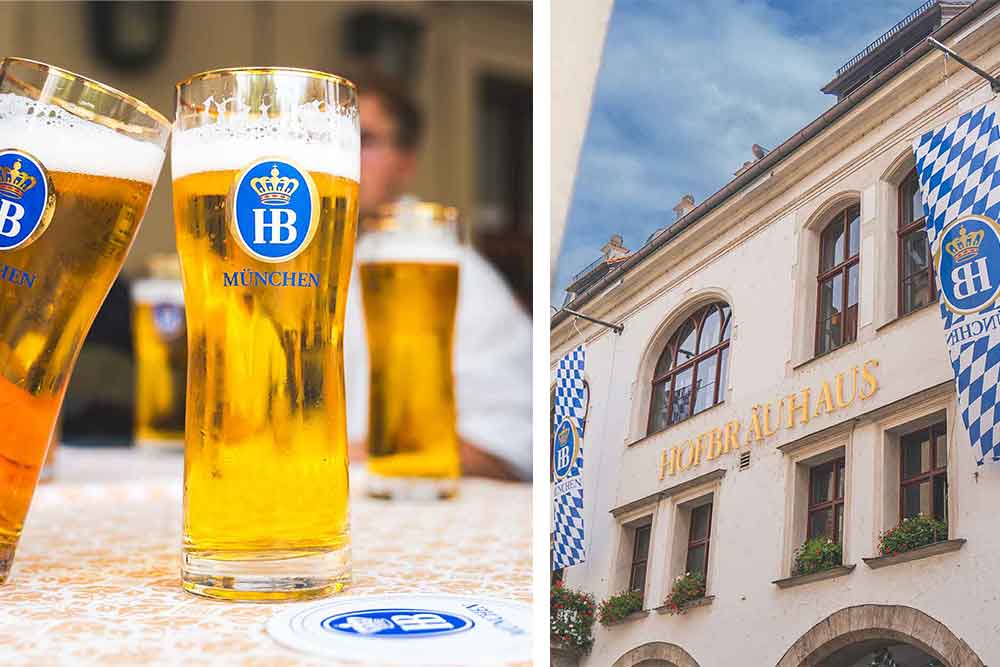
Photography courtesy of Magic Muncie, Social Media Manager, Hop Culture and Untappd
Again, you won’t be short of bumping into people snapping selfies at Hofbräuhaus (or just lots of people in general), but here’s a pro tip: Head to the three-floor beer halls’ outdoor deck, which you can reach through a side entrance. It’s a bit quieter up there, and you can people-watch from above.
The move here is probably the Hofbräu Original, which the traditional Munich brewery believes embodies the “special atmosphere of the beer-making capital of Munich,” according to its Untappd description. A helles that drank a little dry with a refreshing finish, the OG had a touch of bitterness, making it easy to see why this beer has become famous worldwide.
Although if you’re looking for something unique, the dunkel radler was one of the only dark beer/lemonade options we saw through our entire trip.
Also, keep an eye on their seasonal beers, which they switch out based on the season—Urbock in winter, Maibock in spring, Sommerzwickl in summer, and Oktoberfest beer in fall. We were a little early for the Festbier, which they only tap once Oktoberfest officially starts.
Beer & Oktoberfest Museum
Sterneckerstraße 2, 80331 München, Germany
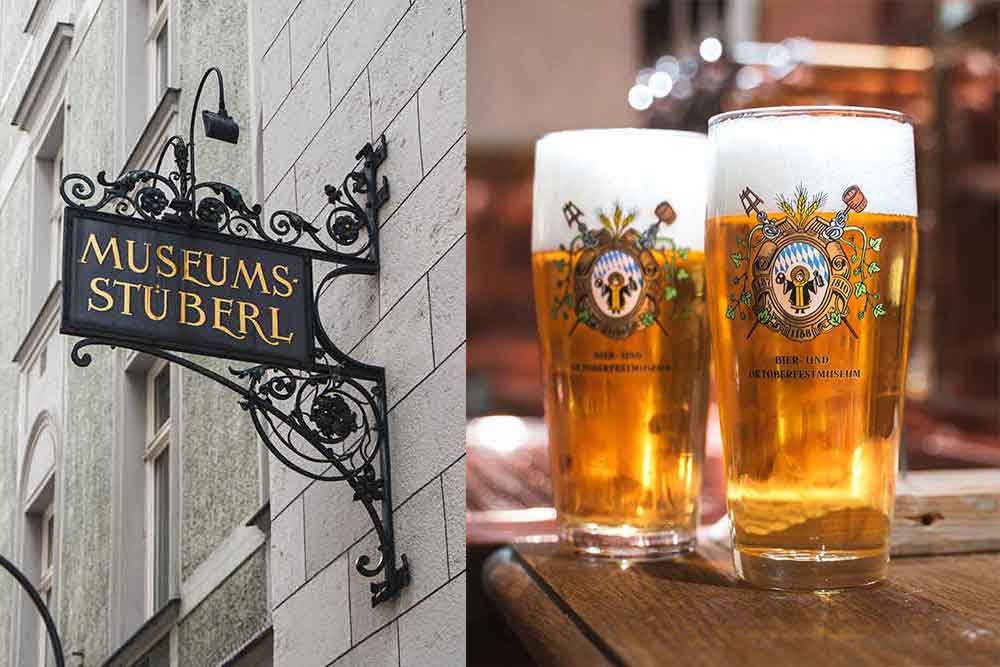
Photography courtesy of Magic Muncie, Social Media Manager, Hop Culture and Untappd
Briefly take a break from drinking to visit this fourteenth-century townhouse and discover fun facts about Munich’s brewing history. You’ll learn about Germany’s Beer Purity Law, the Reinheitsgebot, and encounter Oktoberfest memorabilia.
Still thirsty? Don’t worry, the Beer & Oktoberfest Museum has a tavern in the basement, offering you a free beer with every exhibition ticket.
Augustiner-Keller
Arnulfstraße 52, 80335 München, Germany
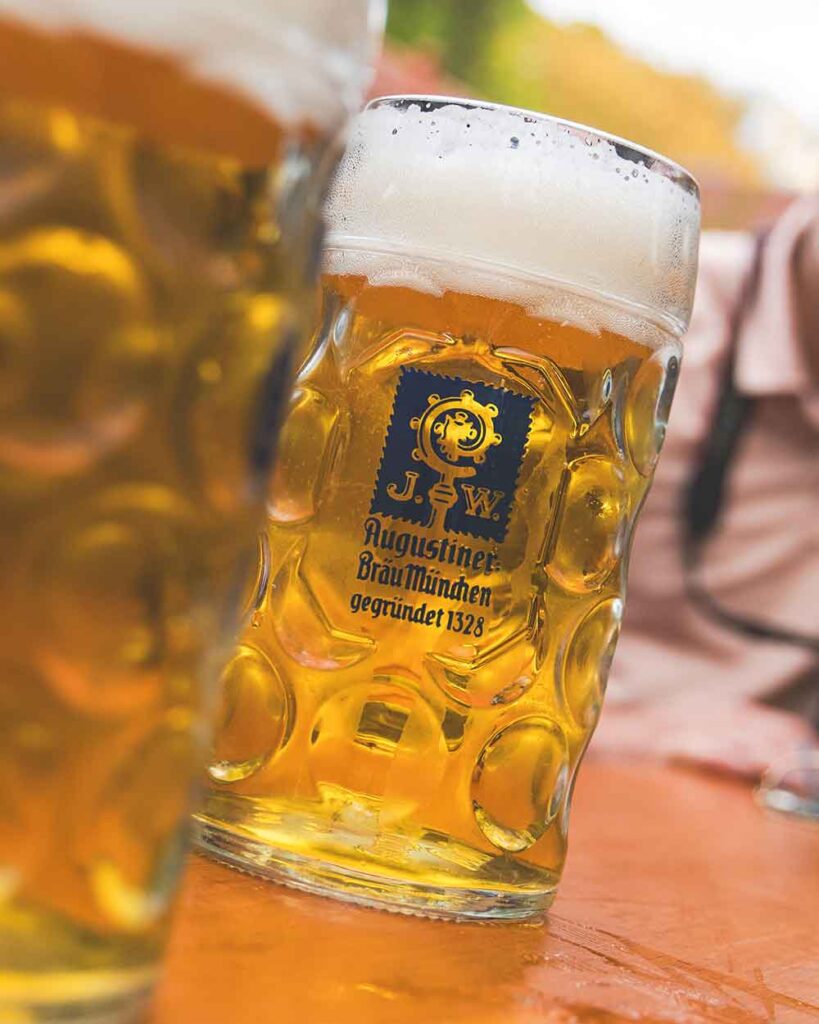
Photography courtesy of Magic Muncie, Social Media Manager, Hop Culture and Untappd
You can’t visit Munich without going to Augustiner-Keller—as Hop Culture Freelancer Ryan Pachmeyer reported when he visited last year. “Augustiner-Keller is an impressive building with a variety of gorgeous rooms. The vaulted Lagereller is most impressive, located underneath the building, with striking red bricks surrounding wooden benches. The location is probably most famous for its biergarten, however, which boasts a capacity of approximately five thousand patrons and is quite a sight to see on a summer weekend afternoon. Every evening, you can find the famous Edelstoff beer poured straight from a barrel.”
While we didn’t have a chance to peek inside, we spent the entire evening having a gay old time in the massive beer garden. To order, we went to one of the many cafeteria-style stalls, grabbed a tray, and pointed to the food items we wanted. And the beer? We can confirm it is indeed pulled from a barrel in front of your eyes. Trays full of food, and a one-liter stein full of beer—Augustiner Lagerbier Helles—you head to the register, paying for everything on the way out.
From there, you just pull up to one of the many, many tables, shaded by giant trees, settle in, eat, drink, and be merry.
This is a must-stop on your Munich itinerary.
Day Two: Nürnberg
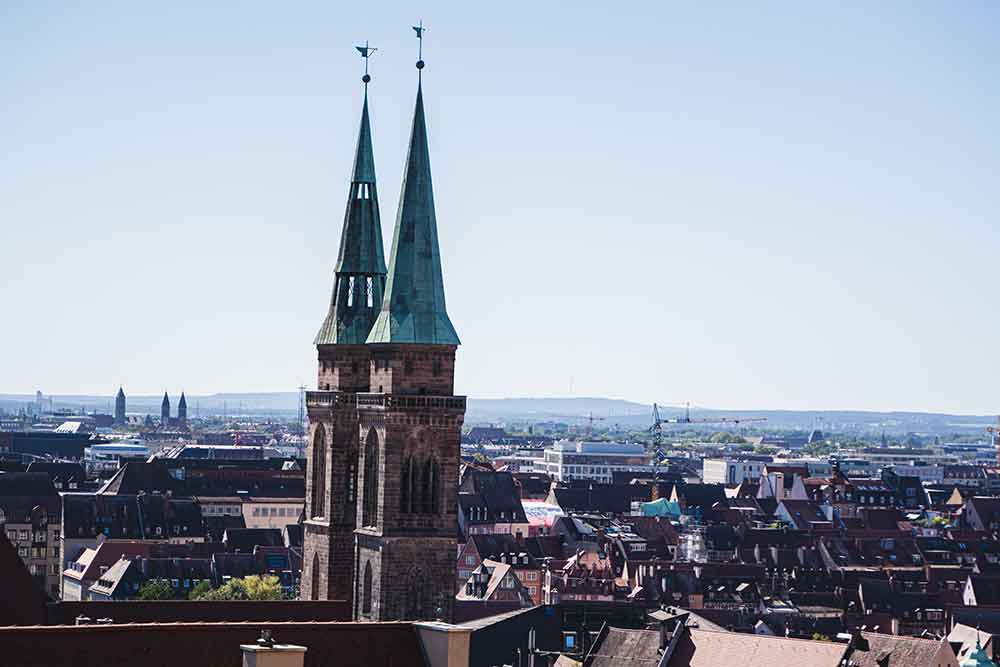
Photography courtesy of Magic Muncie, Social Media Manager, Hop Culture and Untappd
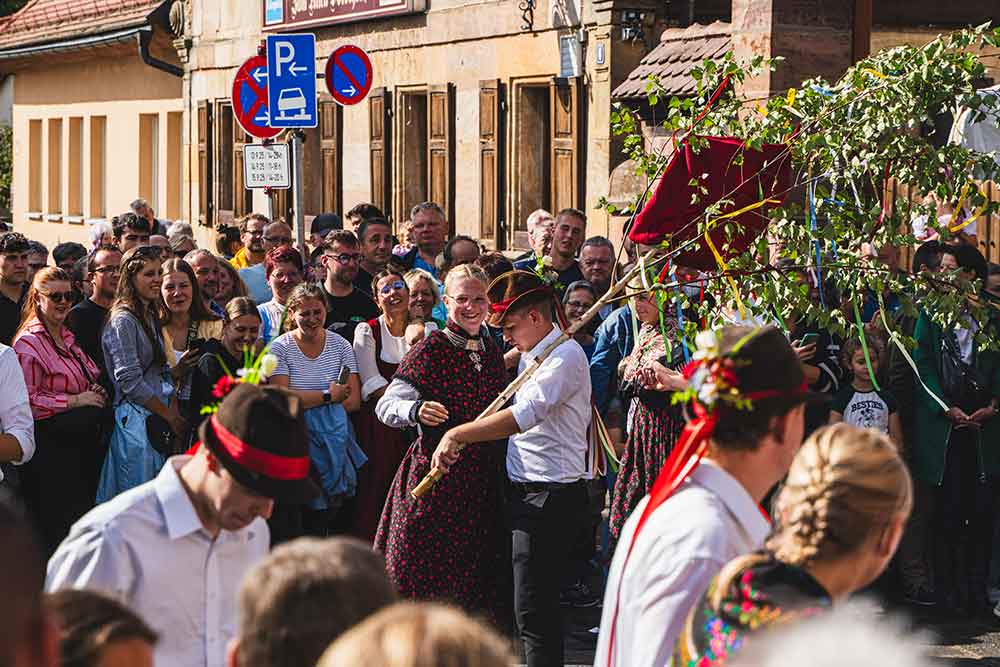
Photography courtesy of Magic Muncie, Social Media Manager, Hop Culture and Untappd
Venture into the Hallertau region for a day of hops, history, and huge mugs of lager.
Deutsches Hopfenmuseum
Elsenheimerstraße 2, 85283 Wolnzach, Germany
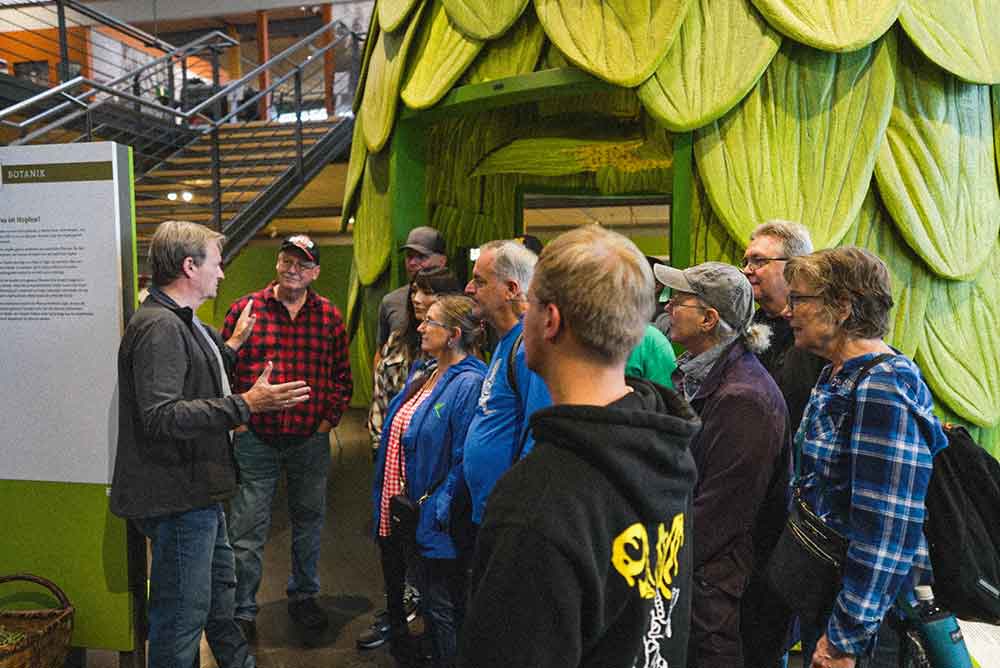
Photography courtesy of Magic Muncie, Social Media Manager, Hop Culture and Untappd
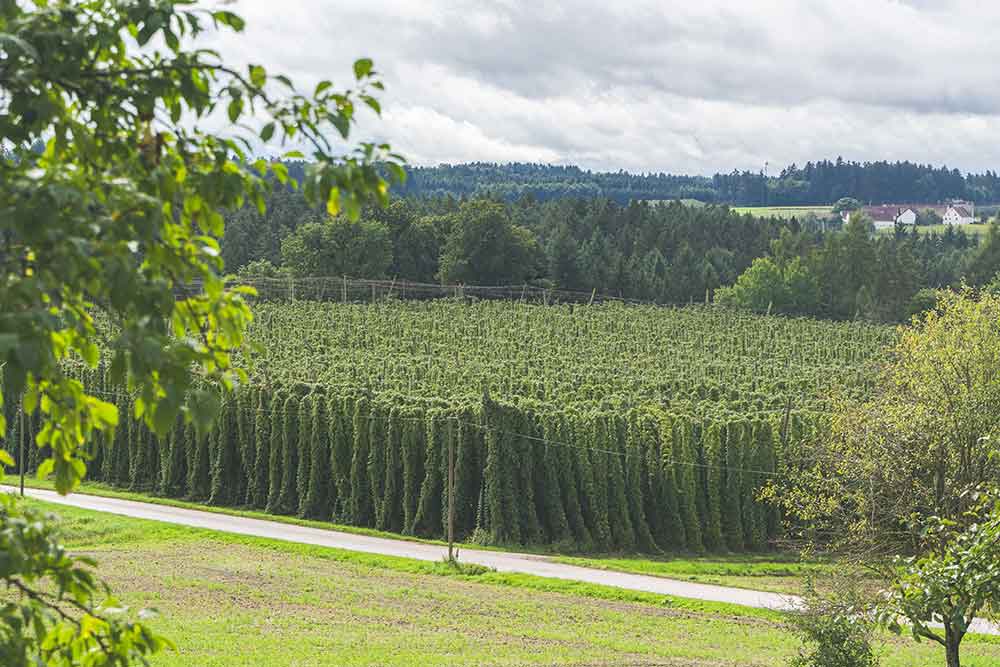
Photography courtesy of Magic Muncie, Social Media Manager, Hop Culture and Untappd
We promise this is the last museum you’ll visit. Hey, you can’t just drink beer all day, can you? Well, sure you can, but it’s good to break everything up with a bit of history behind what’s in your glass, right?
Greeted by a huge, larger-than-life-size hop, Deutsches Hopfenmuseum provides a great way to get intimate with a raw ingredient pivotal to the now-famous Hallertau hop-growing region.
Through two floors, you’ll learn everything you need to know about the German hop industry from its history to current innovations.
Pro Tip: The entire museum shows displays in German, so you’ll either need to shell out €1 to get a one-hour audio tour or have your Google Translate handy.
Siebler Landgasthof & Hofmetzgerei & Biergarten
Egg 9, 85283 Wolnzach, Germany
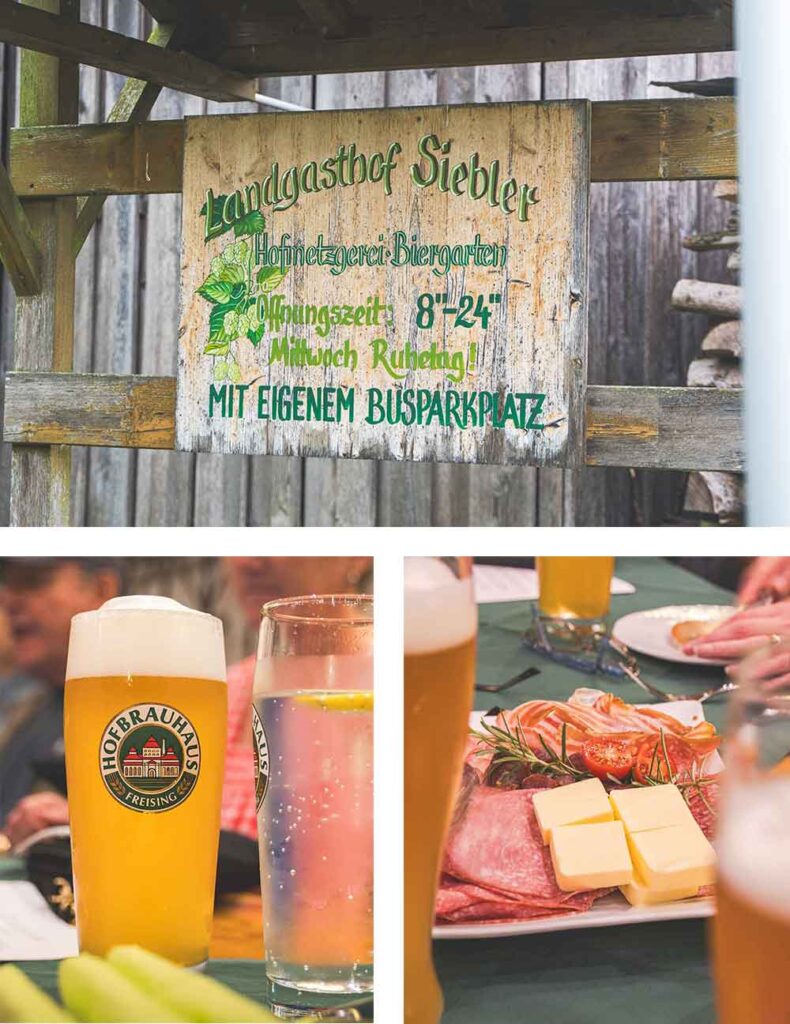
Photography courtesy of Magic Muncie, Social Media Manager, Hop Culture and Untappd
Siebler Landgasthof & Homfmetzgerei & Biergarten is a bit of a trade secret, one we only knew about thanks to the connections from Trip’s Beer Trips.
Be the first to know about our next trip: SIGN UP HERE
A traditional family-run butchery, restaurant, and beer garden, the Hallertau-based establishment pays homage to the raw materials around them by incorporating hops into its charcuterie.
And when we say family-owned, the matriarch herself came to take our orders.
“This is a place I never would have gotten to on my own,” said Paul Young, one of the Untappd enthusiasts who joined us on the trip.
You’ll need to drive into the rolling hills of Hallertau to find this humble house of homemade meats, but trust us, it’s worth it.
Orca Brau
Am Steinacher Kreuz 24, 90427 Nürnberg, Germany
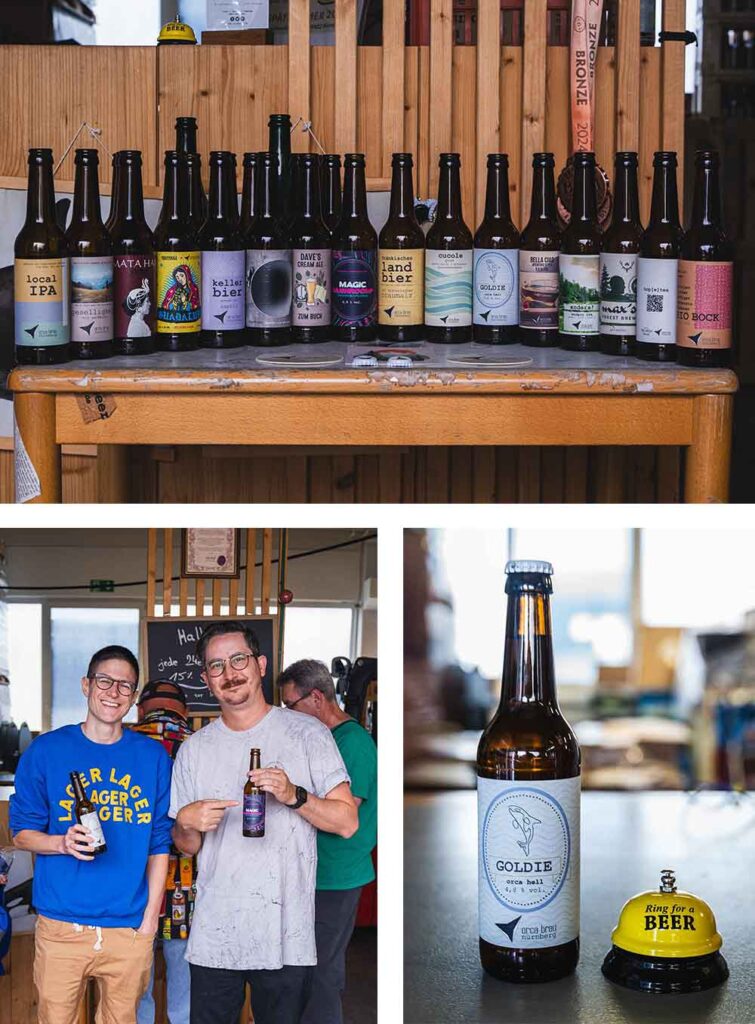
Photography courtesy of Magic Muncie, Social Media Manager, Hop Culture and Untappd
Orca Brau is a craft brewery. While this may not seem Earth-shattering to someone from the States, in Germany, craft breweries are still pretty uncommon. With hundreds of years of bottom-fermenting beer history, German breweries, for the most part, range from small, family-run operations to larger corporations that typically produce a limited roster of beers.
But Orca Brau Co-Founder Felix vom Endt fell in love with what he calls a North American style of brewing when he and his now-wife moved to Vancouver, BC, Canada, for a year.
After running a successful beer blog for five years, vom Endt threw himself into the craft beer industry in Vancouver, working for a small craft beer shop and brewery.
When vom Endt’s Canadian work visas expired after a year, they rented a van and drove up and down the West Coast of the United States. They fell in love with West Coast IPAs, pale ales, and American craft beers from giants like Russian River, Firestone Walker, Hopworks, and Stone.
A pipedream materialized: Opening up their own Northwest American-style brewery back home.
It would be a few more pit stops and years before the dream became a reality, But when the couple moved back to Nürnberg after the birth of their first child, vom Endt took an old, dusty, unused brewkit from the brewery he worked for with him (with permission of the owner, of course, who only gave him one piece of advice: Don’t open up your own brewery!).
Eight years later, Orca Brau has weathered all headwinds, jumped over all obstacles, and aggressively challenged historic German stereotypes to become one of the most underrated craft breweries in the country.
Vom Endt says the idea from day one was to go three directions: traditional styles, modern styles, and push-the-boundaries-as-far-as-we-can experimental styles.
Meaning Orca Brau opened with a pale ale, IPA, and chili-smoked ale, with rarely a core beer in sight in the first few years. Eventually, after getting the right equipment, vom Endt added in a couple more traditional lagers.
But even those had a twist.
One of our favorite beers, a beer called Goldie, includes a blend of traditional barley and a historic Franconian malt revived from near extinction.
“It has its own character—it’s a little bit more caramel, honey,” explains vom Endt, who says this means it’s actually a much harder Pilsner malt to brew with because you have to pay more for it and boil it longer. “But at the end, you have a super interesting and complex product … that makes the beer more interesting to drink.”
And in Franconia, the land of incredible lagers, setting yourself apart is key.
Kerschbaumer, who lives in Nürnberg, had this to say about Orca’s hell, “I drank this and it was perfect!”
On the hoppy side, wanderlust, the brewery’s pale ale, is a best-seller.
Featuring just Pilsner and wheat malt and Citra, Mosaic, and Simcoe hops, wanderlust currently ferments with Lallemand Verdant IPA yeast (used to be US-05) to create a slightly bitter, slightly fruity beer that people love. “It’s just water, malt, yeast, and hops, so that’s good for Germans,” vom Endt says, referring to the 1516 German Beer Purity Law, which says beer can only have those four ingredients. “But it tastes like fruit juice with all those amazing hops, so this hooks people.”
For boundary-pushing beers, vom Endt says Orca Brau’s boomshakalaka has to be one of the craziest.
The smoked ale includes raspberries and chilies, an inspiration from a dish vom Endt saw on the now-defunct cooking competition called The Taste. His first batch included thirty-five grams of habanero chili powder to four hundred liters of beer. “That beer was so f**king spicy!” says vom Endt. “For me, it was undrinkable.”
And while on Orca Brau’s opening day, some people certainly set down their glasses and walked out, “probably never coming back,” jokes vom Endt, others told him, “Wow, this is the best thing I’ve ever had.”
The brewery is known for boomshakalaka, with people constantly asking for the brewed-once-a-year beer.
A self-proclaimed cook, vom Endt likes to make what he calls culinary ales featuring different flavor combinations like strawberry and basil or horseradish and beet.
“For me, this is the most fun part of brewing,” he says.
Fun is what you’ll find at Orca Brau, named after the whales that are known for being strong, persistent, and aggressive.
Which is exactly what Orca Brau has had to be for the last eight years, pushing to make headway in a historically tough-headed, staunch German beer market.
Well, if we may say so, vom Endt has freed Orca Brau from the chains of conventional German brewing and is absolutely killing it.
Orca Brau is a small operation, so when you visit, you’ll probably see vom Endt himself, with his big beard and hearty personality, brewing or bottling. Peek into the beer fridge with all their to-go bottles, pick up as many singles as you can fit in your arms, plop down at one of the picnic benches outside, and drink to your heart’s content at Orca Brau.
Brauerei Schanzenbräu
Proeslerstraße 3, 90431 Nürnberg, Germany
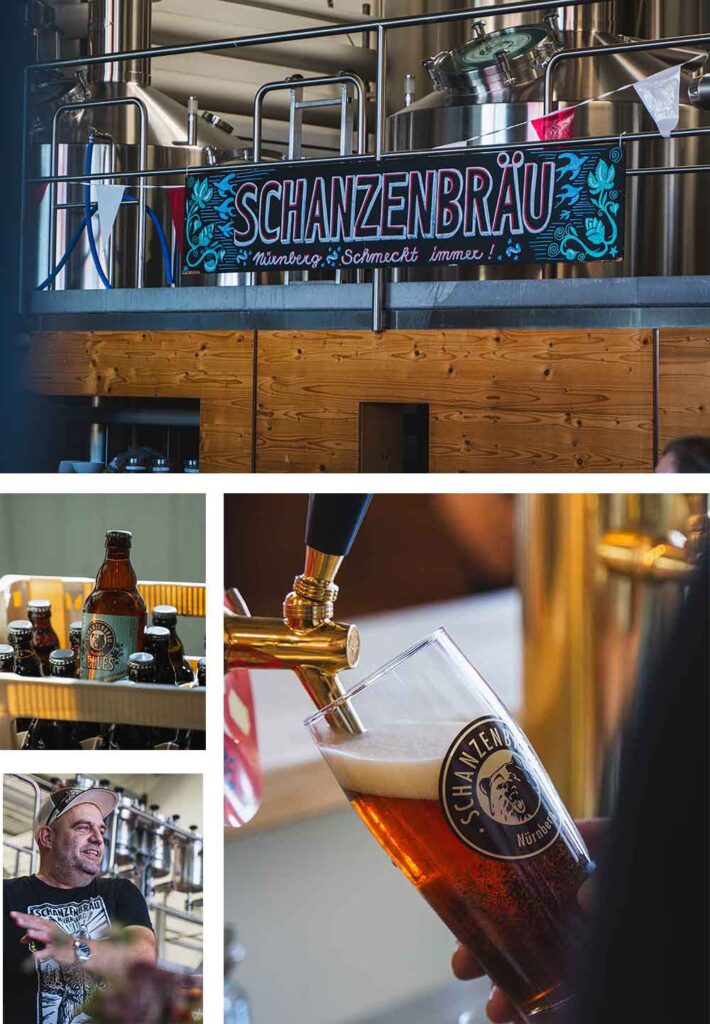
Photography courtesy of Magic Muncie, Social Media Manager, Hop Culture and Untappd
Born and raised in Nürnberg, Brauerei Schanzenbräu Founder Stefan Stretz went to a school between a prison and a brewery. “So I went to the right side and went to the brewery,” laughs Stretz.
We’re sitting in his brewery on the outskirts of Nürnberg, sipping on helles and rotbier, a historic Franconian lager (more on that below).
An engineer by trade, Stretz worked for a cleaning production company by day, brewing and drinking by night.
Throughout his travels to large companies, he collected a variety of items. He used what other people considered trash to open a small brewery in 2004 in the basement of a car repair shop.
“Our goal is to be pioneers of beer culture,” says Stretz of the distinctly more craft brewery.
Drinkability is the keyword at Schanzenbräu, whose red lager, for example, at twenty-six IBUs, is actually one degree above where Stretz likes his beers to be. “Twenty-five is usually our maximum,” he admits. “We like the drinkability of beers.”
Seems to be working. Over twenty years later, Schanzenbräu has grown into the largest private brewery (and the second-largest overall) in Nürnberg.
Using only local malt and hops, Stretz proudly brews beer from Nürnberg. The malt comes from three to five kilometers away, and the hops are from Hallertau.
Beerwise, “Honestly,” says Kerschbaumer, “I recommend everything here.”
But Schanzenbräu is known for its Helles and Rotbier, the former of which Stretz is especially proud. “It’s not that easy to produce a helles,” he explains. “You can’t make any mistakes. … You can’t hide behind anything.”
After enjoying a full glass and a taster off the tanks, we can confirm that Schanzenbräu’s helles was one of our favorites of the trip. Grainy, but not overly sweet, the lager had layers of flavor. Almost like a super light version of Honey Nut Cheerios, a bowl of which you enjoy from the first spoonful to the last slurp of that malty milk.
We could also taste the passion and heart of this place in each of Stretz’s beers.
“I come here every day,” says Stretz, who actually took time out of his own birthday to come show us around Schanzenbräu. “I love what I do.”
Walk Through Nürnberg Imperial Castle
Burg 17, 90403 Nürnberg, Germany
For a quick break from beer, stroll through some castle grounds. The jewel of this Franconian city, the Imperial Castle of Nürnberg, is a cluster of medieval buildings that once represented the power of the Holy Roman Empire and the critical role of Nürnberg as an imperial city.
Today, you can stroll around the twenty or so featured structures.
We highly recommend spending time in the castle gardens and bastions (number sixteen on this map, where you’ll get an incredible view of the city in a beautifully manicured outdoor conservatory).
Hausbrauerei Altstadthof
Bergstraße 19, 90403 Nürnberg, Germany
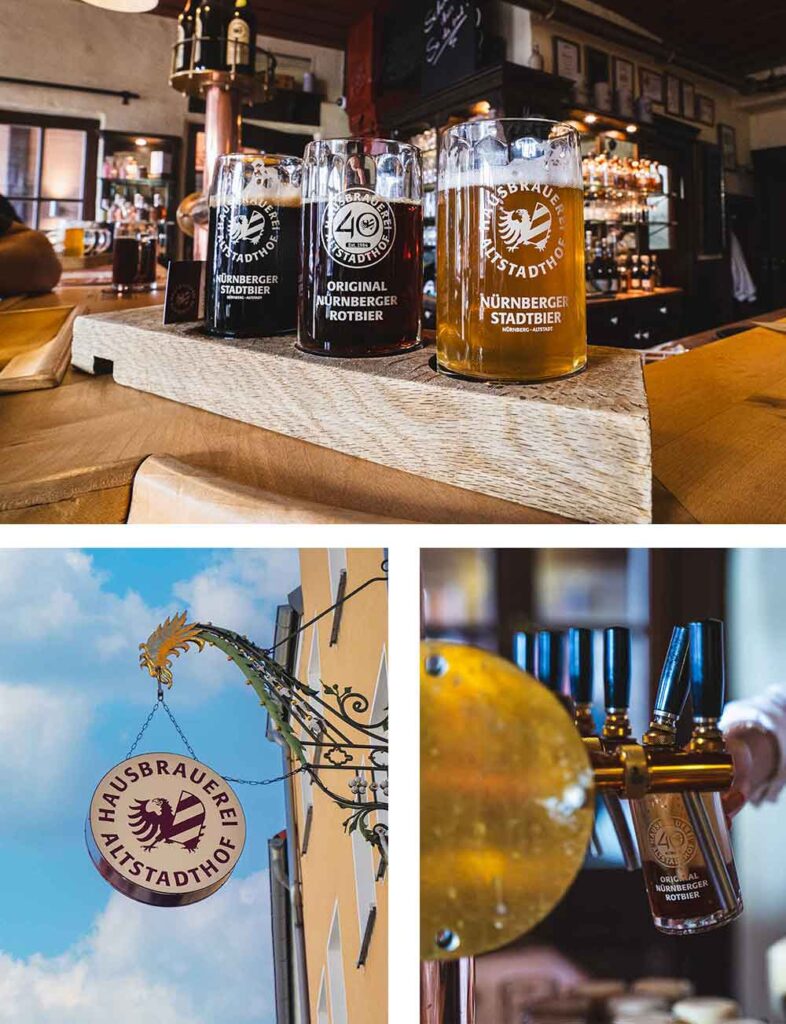
Photography courtesy of Magic Muncie, Social Media Manager, Hop Culture and Untappd
After ambling through history, it’s time to drink through it. Situated in the heart of the old town, Hausbrauerei Altstadthof is located on one of the winding streets at the base of Nürnberg Castle.
“As this is Nürnberg, they are known for their red beer,” Kerschbaumer told us as we all sat around the bar at Hausbrauerei Altstadthof while the bartender expertly filled small steins with a ruby red liquid.
She poured with precision, opening up the tap to fill the mug little by little, “building up the foam so that you have a thick foam that lasts longer than two to four seconds,” explained Kerschbaumer. “This is how we pour beer here.”
The strikingly beautiful lager known as Rotbier is endemic to Nürnberg.
“And it’s not pronounced root beer,” Kerschbaumer cautions us. It’s more like wrote beer.
The rustic Franconian lager should have a low Noble hop bitterness with a predominantly medium toasted malt sweetness.
A distinctly jeweled garnet red, Alstadthof’s Nürnberger Rotbier smelled like sweet cherry. Almost a little roasty, with a hint of warm chestnut, this rotbier finished with an almost browned, buttery nuttiness. Dry in the back, like raspberry jam on multigrain toast, this amber lager lit up the room.
It’s been a pretty long day, so we also recommend grabbing dinner here before getting a good night’s sleep.
Day Three: Erlangen
Drink in the romanticism of Germany’s incredible beer gardens and mountain cellars.
Walk Through the Kellerwald
In Forchheim, you’ll find the Kellerwald, a collection of twenty-four kellers (aka cellars) dug into the side of a hill amidst a beautiful forest. You could spend an entire day here, essentially keller-hopping from beer garden to beer garden. Wind your way through paved tree-lined trails, stopping at whatever small beer-laden hole in the “mountain” strikes your fancy.
Keep in mind, though, Kellerwald-hanging has a specific season. Normally operating from April through October, the Kellerwald gets busiest in July when it hosts Annafest, a ten-day folk festival that’s similar to Oktoberfest with one-liter krugs of beer aplenty.
We happened to visit during an off-peak time, so while a few of the kellers were open, we didn’t stop at any in particular.
Instead, we hoofed it down the winding road to a great place at the bottom of the hill.
If you’re looking for more information on the Kellerwald, our friend at Beerwanderers has a great write-up here.
Greif Keller
Auf den Kellern 9, 91301 Forchheim, Germany
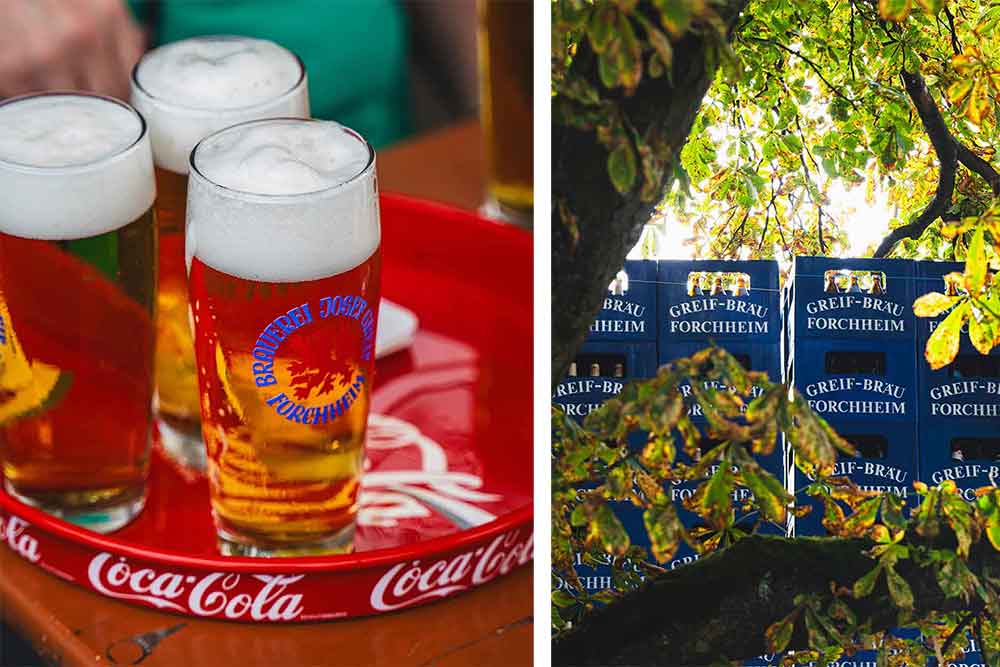
Photography courtesy of Magic Muncie, Social Media Manager, Hop Culture and Untappd
A sort of old-school tavern, Greif Keller had one of our favorite helles right from the barrel.
“So, guys, something about the beers,” Kerschbaumer told us as they began filling our glasses with helles straight from the barrel. “You see all the awards they’ve won. They’re World Beer Award winners two years in a row.” Most recently, for their Annafestbier, brewed only for the Franconian festival held in late July and early August.
Pouring a clear, almost smudgy gold, Greif Hell had a decent minerality to it, like rocks from a stream, with a bit of maltiness in the background.
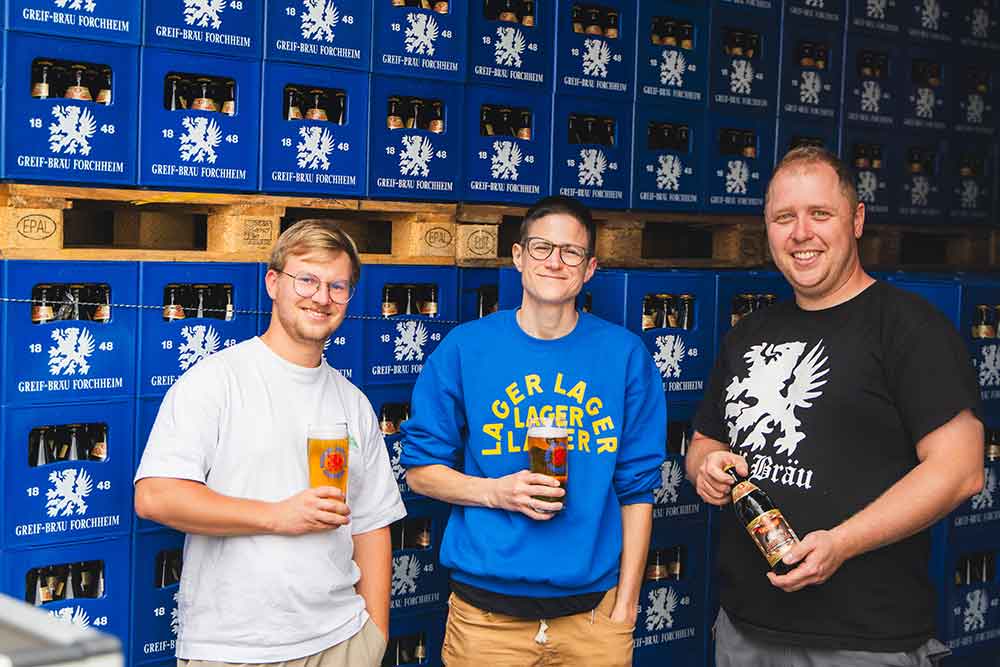
Photography courtesy of Magic Muncie, Social Media Manager, Hop Culture and Untappd
You can tell this is a locals’ place with its lingering scent of cigarette smoke inside and groups of friends conversing in German while drinking outside.
The beautiful day had us all hanging outside, but if you do need to spend time indoors, it’s almost like stepping into a time warp.
Wooden benches with little blue pads cushion your butt, while stained glass windows and an old jukebox made me feel like I might be in my grandma’s New York apartment. In the best way, of course.
Greif is just low-key drinking in Germany at its finest.
Entla’s-Keller Beer Garden
An den Kellern 5-7, 91054 Erlangen, Germany
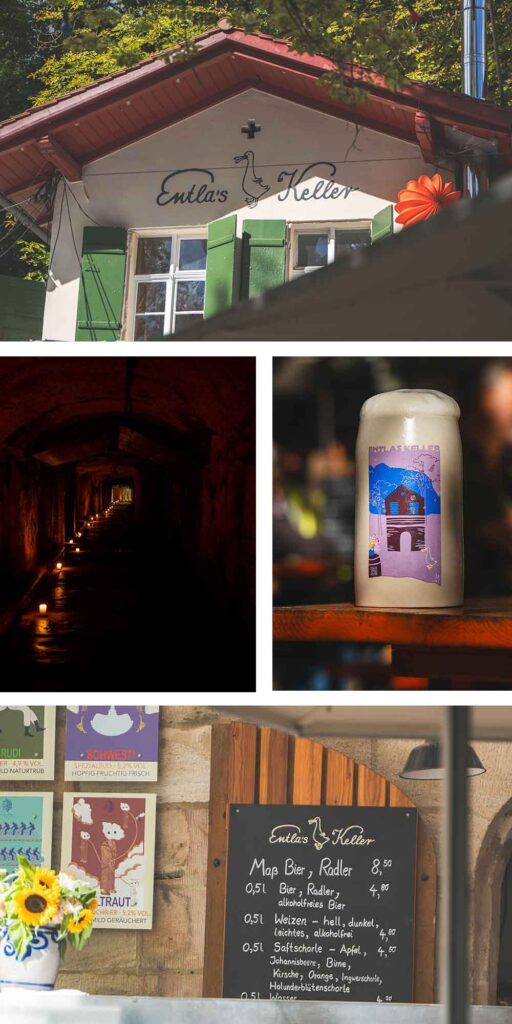
Photography courtesy of Magic Muncie, Social Media Manager, Hop Culture and Untappd
We stood in a circle in darkness, listening. For thirteen seconds, our voices reverberated against the tunnel walls, echoing ohhhh, ohh, oh. As the last long “O” disappeared like a whisper in a crowd, we all took a deep breath. Almost cleansed, we prepared to yell at the top of our lungs one more time.
We were deep inside the kellers of Entla’s-Keller, “the heart and soul of Erlangen,” according to Matze Havel, who showed us around the twenty-one kilometers of tunnels dug to store beer through the Erlanger Burgberg (which translates to Castle Mountain in English).
Long before Erlangen became a university town, another industry dominated: beer.
Twenty-three breweries once called Erlangen home, thanks in part to the natural mountain cellars that helped Erlangen historically become one of the largest beer-exporting cities in Europe, even surpassing Munich at one point.
Before heading inside, Havel held up his hand, his fingers twitching slightly. “If you listen carefully to my words, you’ll see what I have in my hand here,” he almost whispered. “It’s a nice, red beating heart. Follow this. Follow me.”
Heart, soul, and lots of sweat go into everything at Entla’s-Keller: that and a little ingenuity. Oval-shaped shafts bored into the hill, carved specifically by hand with picks and hammers in the most stable form: an egg.
Slightly chilly, the keller stays at a cool, constant eight degrees Celsius (about forty-six degrees Fahrenheit). “It doesn’t matter if it’s summer or winter,” says Havel. “The whole year long, the mountain gives us eight degrees.”
Although perfect for top-fermenting beers, the constant eight degrees Celsius needed to be lowered four degrees to help bottom-fermenting beers. To do this, brewers used what Havel refers to as “white gold,” aka ice. Not forty meters down the hill is the Ludwig channel, which locals call the “Franconian Flowway.” The former shipping channel froze every year, making it perfect for ice farming.
As we crowd into the cellar, Havel explains how owner Fritz Engelhardt’s parents bought the business when he was a young boy. Now seventy-three years old, Engelhardt “found his lifetime hobby” in the depths of the darkness, according to Havel. Even today, when the keller closes in September, Havel says you’ll find Engelhardt underneath, fixing and repairing.
“We call him a Franconian word: KellerRatz,” says Havel. “It means cellar rat in a nice way!”
After German engineer Carl von Linde invented a cooling machine in the 1870s, the need for Erlangen’s chilly cellar quickly waned.
Although no longer a famous beer-exporting city, Erlangen and Entla’s-Keller still stand, a testament to Erlangen’s place in German brewing history.
Havel often talks about Erlanger Mountain with reverence, treating it more like a grandfather than a geological feature—much like we say Mother Nature. Havel himself seems to personify the mountain—stout, resolute, powerful. Although he isn’t related to the Engelhardts by blood, he shares his Erlangen heritage. Havel grew up here, studying outside in Entla’s-Keller’s beer garden before working for the family.
Before we go into the deepest and biggest cellar, Havel challenges us. “Open your heart,” he says. “Inhale the atmosphere, sharpen your senses, listen, look, and smell more than normal.”
Inside, we’re quickly enveloped by darkness. Only candles lining the path show us the way.
“I will show what darkness means down here,” Havel assures us. “Enjoy the darkness!”
If we do what Havel says, giving in to all of our senses, we can hear a steady beat.
“Do you hear the pulse of the mountain?” asks Havel, who himself has been the beating heart of Entla’s-Keller, showing people who dare its secrets.
Although Entla’s-Keller stored beer, it was never actually a brewery. That all changed in 2021, when Engelhardt installed a fully automated, emission-free fifteen-hectoliter brewhouse into the mountain.
The decision has made Entla’s-Keller very unique.
“In Europe for sure and maybe worldwide, we are the only brewery that is fully brewing, storing, and fermenting beer in a mountain,” shares Havel, who considers himself a cellar nerd, even getting married in one of the cellar’s tunnels—what he calls the “heart chamber of the hill.” “So what you drink maybe later on, it’s the only real cellar beer you can have on Earth.”
As we emerge from the darkness into the sunlight once more, Havel encourages us to turn around again, giving one more lingering gaze at the cellars, a lasting picture of peace in our memory.
“There is a world down there,” Havel says, “An underworld.”
We followed Havel with his heart in his hand into the mountain, and we emerged with our own pulses peacefully slowed.
Now, to drink the only mountain-brewed beer in the world.
“What don’t you see here?” Kerschbaumer asks us as we sit down at long picnic tables with a spread of cheese, fruit, pretzels, smoked meats, and more in front of us. “Tourists.”
He goes on to explain that this is a very local spot. “These are the places we want to take you.”
“Munich is all about big crowds,” he says. “Erlangen is not.”
This place is special and one of our favorite stops of the entire trip. We cannot recommend the cellar tour highly enough. Costing only €8 and offered every Sunday at 11 a.m. or Friday at 7 p.m. starting from early April until the end of September, the cellar tour is a must if you’re in Erlangen.
Steinbach Bräu
Vierzigmannstraße 4, 91054 Erlangen, Germany
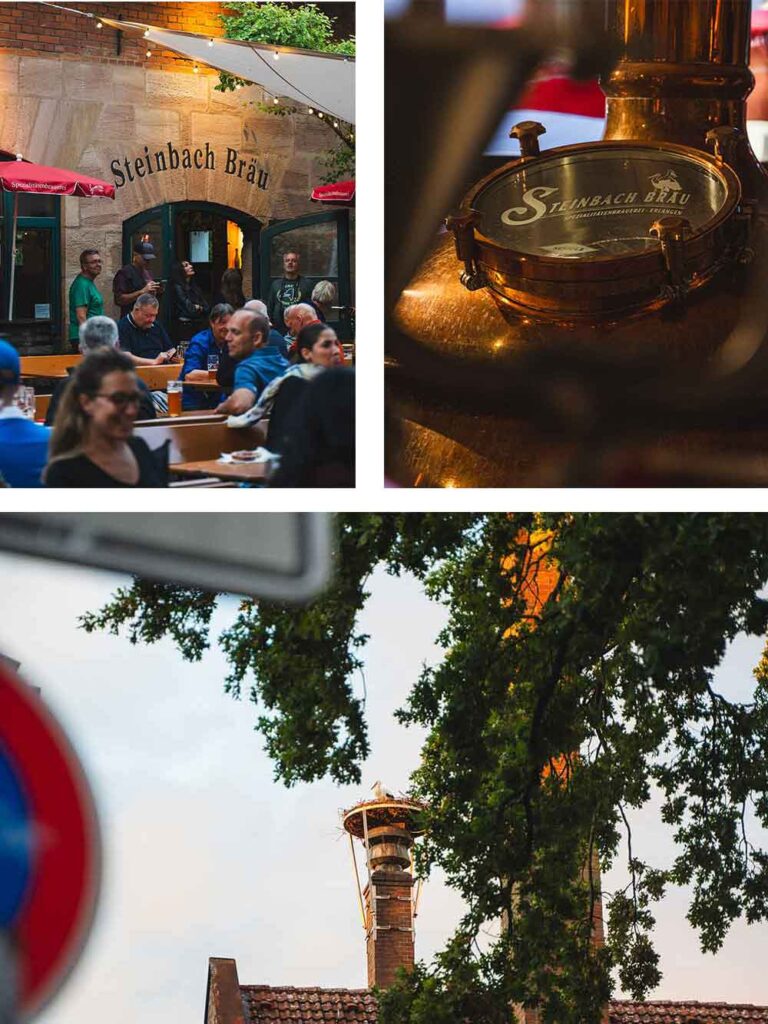
Photography courtesy of Magic Muncie, Social Media Manager, Hop Culture and Untappd
We recommend taking a twenty-five-minute stroll from Entla’s-Keller into Erlangen to get to dinner and more beer at Steinbach Bräu. Pass through the Botanischer Garten (the botanical garden), with its manicured grounds, flowers, and fountains, and the Altstadt, or old town, featuring French-like cobblestone streets and plazas.
End your long walk at Steinbach Bräu, acquired by Carl Steinbach in 1861, when Erlangen was at its peak in beer exporting.
Today, Carl’s sons, Karl and Fritz Steinbach, continue to run the brewery, which even has its own malting house. Combined with hops from Spalt, Erlangen water, and Weihenstephan yeast, Steinbach produces distinctive beers in accordance with the German Purity Law.
For instance, Storchenbier, a classic kellerbier made to celebrate the storks that ceremoniously roost on the brewery’s rooftop (there’s even a live stork cam you can check out to see the storks in action).
Straw gold and crystal clear, this bottom-fermenting beer, based on an old recipe, had a bit more maltiness to it than some of the other kellerbiers we tried—like chewing on oat flakes.
The beer went perfectly with the cheese plate we ordered, but would pair equally well with the rest of the brewery’s menu, which included, among other things, Original Franconian grilled sausages with sauerkraut or potato salad, Obatzter, homemade Bavarian cheese mixed with spices, baked camembert with cranberries and salad, or käsespätzle, Swabian cheese noodles, with salad.
Day Four: Bamberg
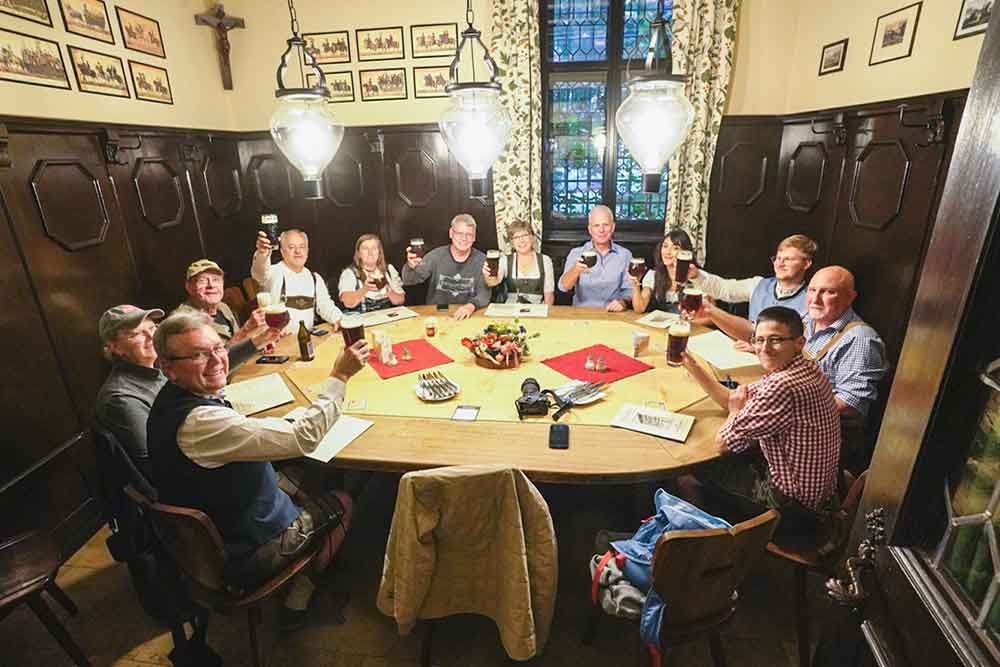
Photography courtesy of Magic Muncie, Social Media Manager, Hop Culture and Untappd
Let’s be clear: Today, things are getting a little smoky. And you should love every foggy, umami, bacon-y minute of it. Much like Nürnberg is known for its rotbier, Bamberg in Northern Bavaria is known for one specific smoky beer—rauchbier.
Interested in hearing when we curate our next trip? Sign up here to get updates first.
Mahrs Bräu
Wunderburg 10, 96050 Bamberg, Germany
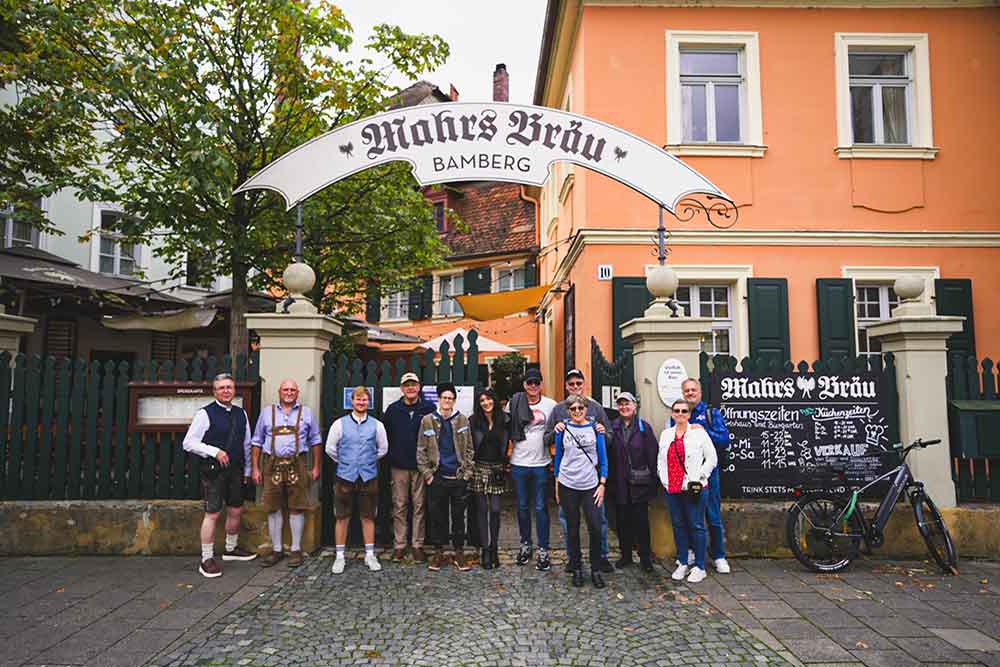
Photography courtesy of Magic Muncie, Social Media Manager, Hop Culture and Untappd
We learned about Mahrs Bräu after repeated appearances during the Firestone Walker Invitational. So, when we planned the Untappd Epic German Bier Experience, we knew that this Bamberg-based brewery had to be a must-stop.
A popular spot in the Northern Bavarian city, Mahrs Bräu, according to our guide Kerschbaumer, “is usually completely full on the weekends.”
When we visited on a Tuesday, people hung out in the front beer garden, chomping on bowls of noodles with fresh mushrooms, a special of the day.
Inside, where we sat, families walked in with kids, who were given mugs of juice placed in front of them, next to the adults, who had one-liter steins of aU, or Ungespundet, which means unbunged, referring to traditional German practice where you leave the barrel loosely covered to allow excess carbon dioxide to blow off, resulting in a beer with lower carbonation.
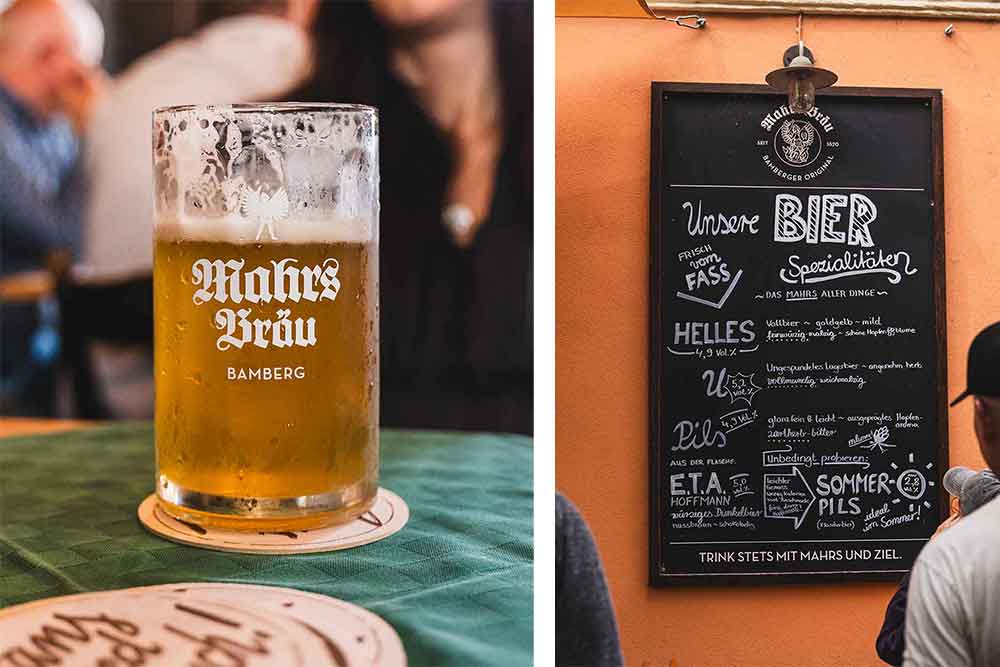
Photography courtesy of Magic Muncie, Social Media Manager, Hop Culture and Untappd
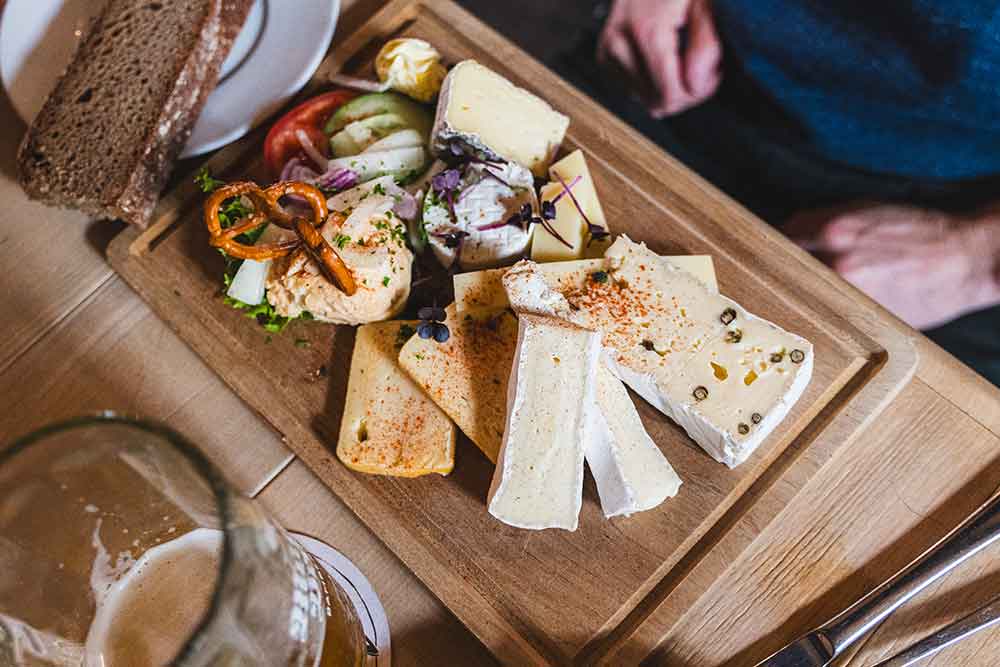
Photography courtesy of Magic Muncie, Social Media Manager, Hop Culture and Untappd
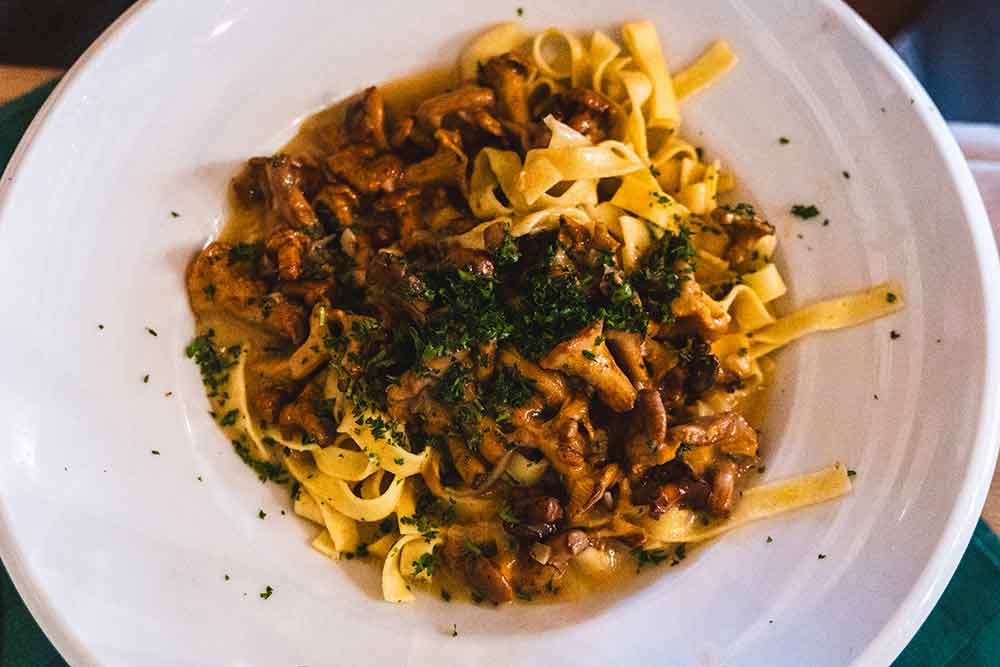
Photography courtesy of Magic Muncie, Social Media Manager, Hop Culture and Untappd
Although this Kellerbier is no longer served by gravity, the beer still drinks deliciously, with a decent maltiness reminiscent of Honey Nut Cheerios and just a hint of lemon verbena in the finish.
While we didn’t try it, Hop Culture Freelancer Ryan Pachmayer also recommends the E.T.A. Hoffmann, a deep, dark Munich dunkel with layered chocolate and caramel flavors. “It is not to be missed,” he says.
Pro tip: The cheese board is pretty good here, too—big enough for at least two or maybe even three people to share!
Keesman Bräu
Wunderburg 5, 96050 Bamberg, Germany
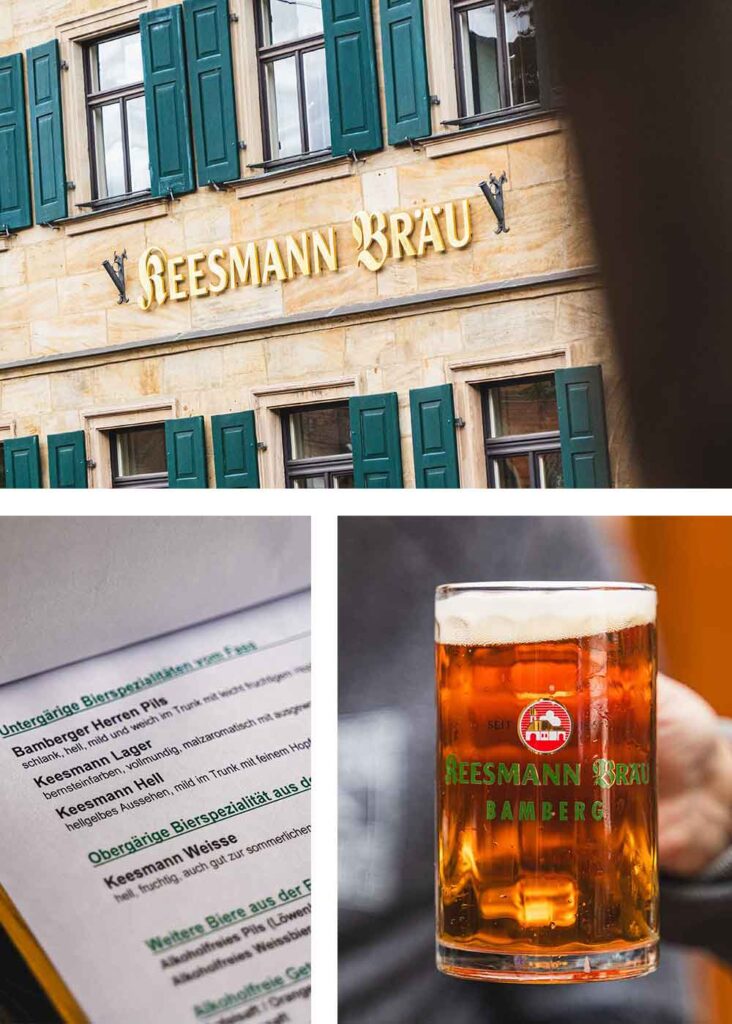
Photography courtesy of Magic Muncie, Social Media Manager, Hop Culture and Untappd
Within spitting distance of Mahrs Bräu, Keesman Bräu produces the Bamberger Herren Pils, which Pachmayer thinks many visitors should add to their shortlist, thanks to its “striking bitterness but a rounded malt flavor underneath to balance.”
We actually tried the Sternla Lager, an amber lager that had a touch of a torched marshmallow flavor and caramel roast. Nice, rich, and crispy, this amber reminded me a bit of a Samoa Girl Scout cookie with a chewy note of caramel and chocolate.
When you have two wunderkind breweries, kitty-corner from each other, you could spend the whole afternoon on this one street.
But we have another world-class company to visit.
Weyermann Specialty Malts
Logistikzentrum, Brennerstraße 17-19, 96052 Bamberg, Germany
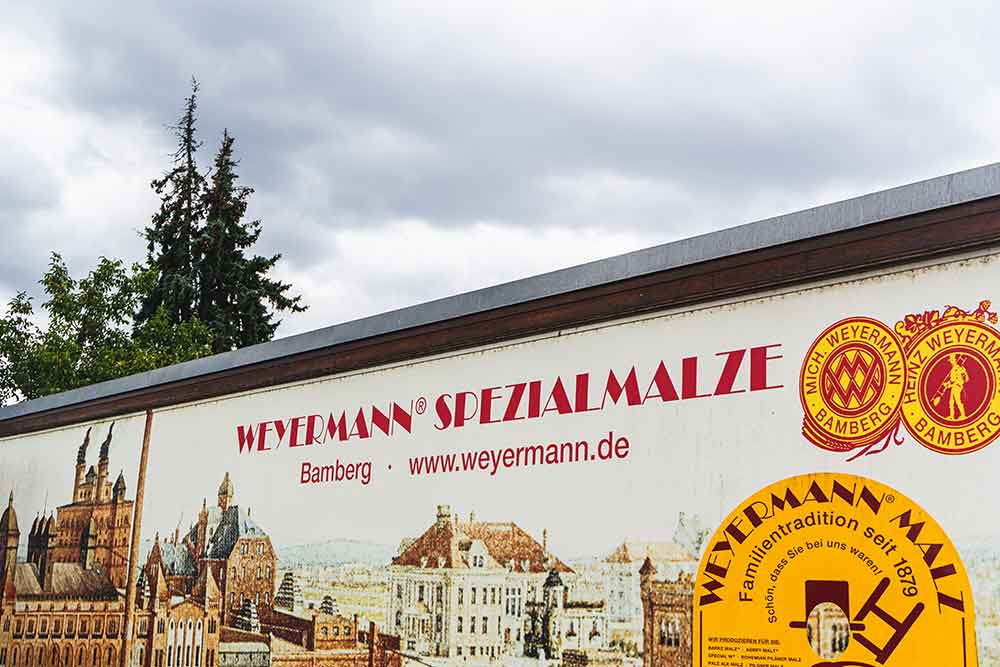
Photography courtesy of Magic Muncie, Social Media Manager, Hop Culture and Untappd
One of the world’s most renowned malt makers, Weyermann, opens its doors to tours. Many brewers around the world consider this historic maltster the cream of the crop, if you get what we mean.
Step back in time to the sixteenth century, immersing yourself in the iconic world of Weyermann, renowned for its vibrant red and yellow hues.
From the lab to the production site to the germination boxes and roasting facility, where you’ll see the roasting drums in action and taste a whole table full of Weyermann’s specialty grains, you’ll discover how Weyermann grew from roasting grain under a tent to a world-leading malt maker.
The tour ends at the maltster’s own bar, where you can taste beers with Weyermann malt in real life.
Highlights from our visit included a Schlotfegerla rauchbier and Meet me at the Festzeh festbier.
Schlenkerla
Dominikanerstraße 6, 96049 Bamberg, Germany
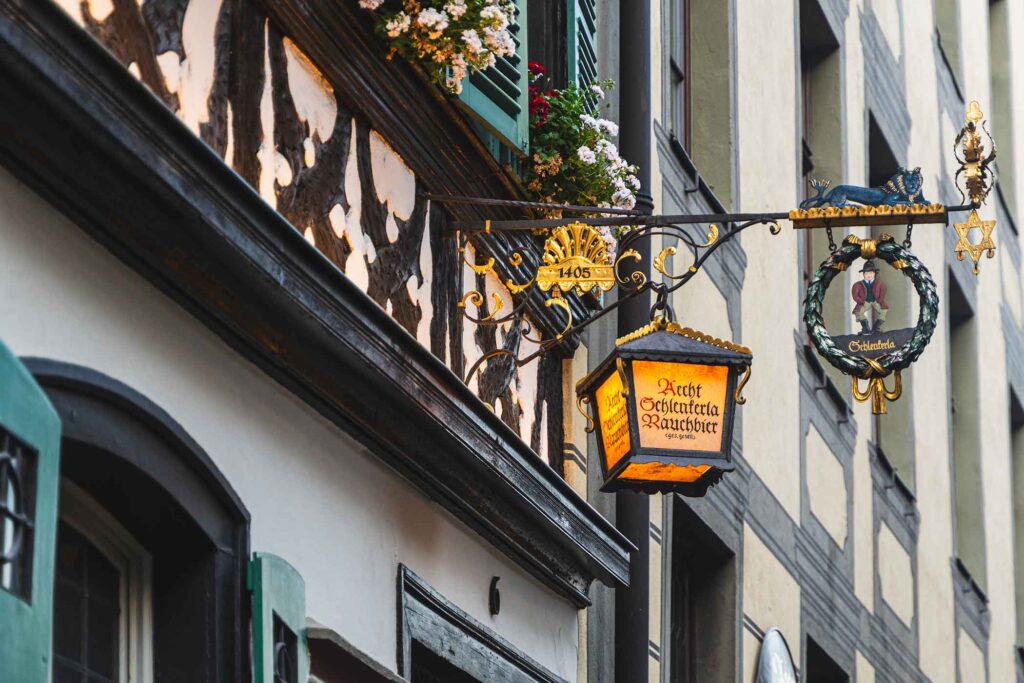
Photography courtesy of Magic Muncie, Social Media Manager, Hop Culture and Untappd
Just look for the streetlight.
Down one of Bamberg’s cobblestone streets, underneath the streetlight, you’ll find one of the most quintessential smoked beer breweries in the world—Schlenkerla.
All beer was once smoked beer or rauchbier in German. “It’s a lost knowledge that smoked beer was the original way of making beer,” sixth-generation “Heller-Bräu” Trum, more commonly known as Schlenkerla, Brewmaster Matthias Trum tells us from his childhood bedroom above the historic smoked beer tavern in Bamberg, Germany.
Rauchbier, which literally translates to “smoked beer” in German, gets its distinct campfire-like flavor from drying malt in a kiln fueled most commonly by Beechwood.
The polarizing style has a fascinating, if slightly smoky, history, surviving near extinction thanks partly to Schlenkerla in the Bavarian region of Germany.
Pro Tip: If you want to read all about it, head here.
One of the most classic interpretations of the style still alive today, Aecht Schlenkerla Rauchbier has to be at the top of your must-try rauchbier list. The dark, aromatic, bottom-fermented 5.1% ABV lager—essentially a smoked Märzen—is brewed with Original Schlenkerla Smokemalt and tapped according to the old tradition directly from the gravity-fed oakwood cask in the fourteenth-century brewery tavern.
This beer has quite a history, surviving near extinction. And when the smoke cleared, this smoked beer made a place for itself in local lore.
“There’s an old Bamberg proverb that when you drink smoked beer,” says Trum, sixth-generation brewer, “you have to drink three pints to fully appreciate the aroma and flavor.”
On a cold fall night in September, we tramped through the quaint alleys of Bamberg, down a small side street, to bow our heads under the iconic Schlenkerla lamp that stands resolute outside the tavern, welcoming weary travelers inside to whet their whistle.
When we visited, the pub was packed wall to wall, with people spilling out into the street, holding pints of dark beer snugly in their hands.
Our guide, Kerschbaumer, who accompanied us for six days as we visited breweries from Munich to Bamberg and throughout Franconia, provided us with valuable advice on how to drink this beer.
“Savor it,” he told us. “You won’t find a beer like this anywhere else in the world.”
Taking a sip of this distinctly smoky, umami beer made the constant hubbub in the tavern’s main dining room melt away. Truly a best-beer-drinking moment, we savored this pint.
“The classic Märzen smoked beer is made with (basically) one hundred percent smoked malt and a tiny bit of roast malt to fill out the color differences between malt batches,” says Trum, “because obviously with an open fire, you cannot adjust the color as exactly as in a modern kiln.”
While brewing, Schlenkerla employs a decoction mash to accentuate the malt’s distinctive notes. “By boiling the mash, you add additional flavors, and you get a more intense and more bread-like aroma in the beer,” explains Trum.
The classic Märzen smoked beer lagers for two months before it’s ready to drink fresh out of wooden barrels in the tavern, which, if you follow Trum’s advice, is the best place in the world to drink it.
”When you sit on a chair which has been around for 100 years, the table 150 years, and the room around you is 500 years old,” Trum emphasizes, and drink an Aecht Schlenkerla Rauchbier right from the wooden barrel, well, that will never get old.
Three pints later (okay, we only had two), we indeed agreed.
Schlenkerla is one of the main reasons why you visit Bamberg. This is a pilgrimage you have to make while in Bavaria.
Spezial Keller
Sternwartstraße 8, 96049 Bamberg, Germany
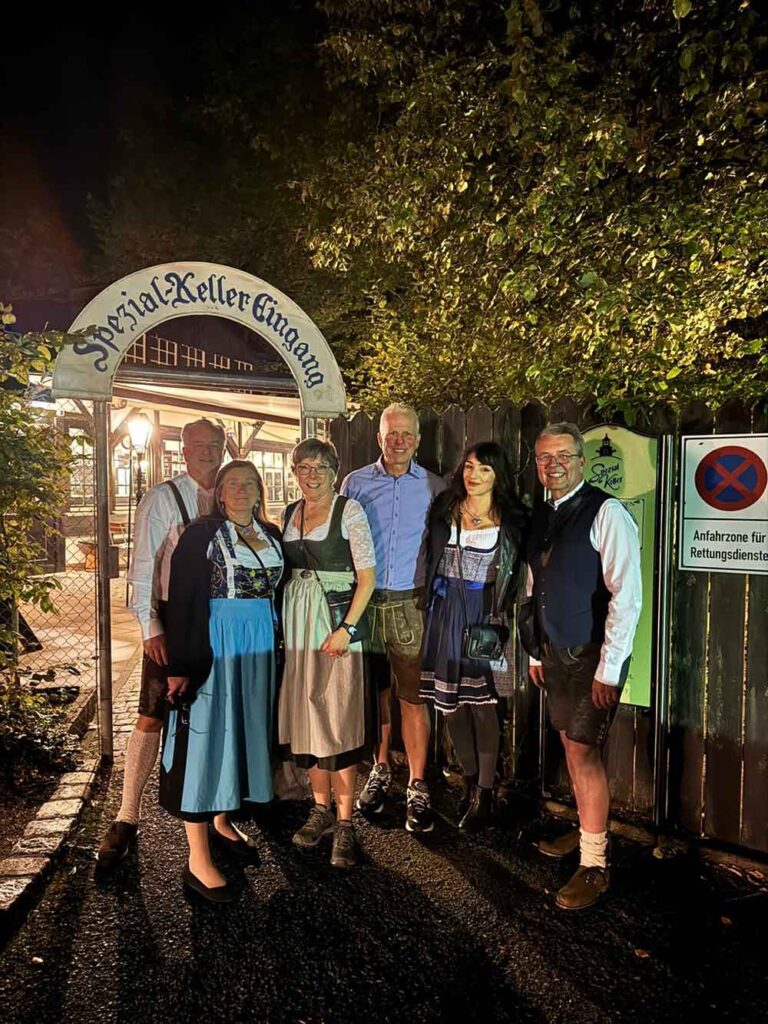
Photography courtesy of Magic Muncie, Social Media Manager, Hop Culture and Untappd
When in Bamberg, another smoked beer specialist you should try is Spezial. While they have a tavern in town, we highly recommend taking a little trek uphill to their keller.
To get there, you’ll navigate a series of winding cobblestone streets. Whereas Schlenkerla beats loudly with hubbub, Spezial’s keller hums quietly. The farther you walk from the center of town, the quieter it gets. As you crest a final hill, you’ll see a string of lights outside what looks like a lovely country house.
Definitely more of a local spot, Spezial Keller is like a smoked beer refuge, a safe port away from the storm of the city.
The smoked beer itself is also more muted than Schlenkerla’s, as our waiter explained to us.
Definitely more mild, Spezial Rauchbier Märzen still had a pleasant smoky backbone, but it was more like pipe smoke instead of cigar smoke, if you get our drift.
Instead of drinking straight-up bacon, it was like sipping a beer while bacon is cooking somewhere inside the house. You get a pleasant hug from the smokiness instead of a punch in the face.
We highly recommend trying both Schlenkerla’s and Spezial’s rauchbiers just to get an idea of the nuances of the style.
Pro Tip: Try the radler made with smoked beer. Our guide said he’s never seen another one like it.
Day Five: Around Bamberg
We love this city and could easily spend a whole week here, as there are numerous incredible, often family-run breweries throughout Bamberg. So much so that it’s worth dedicating one day to either driving or biking around to find them.
Brauerei Witzgall
Schlammersdorfer Str. 17, 91352 Hallerndorf, Germany
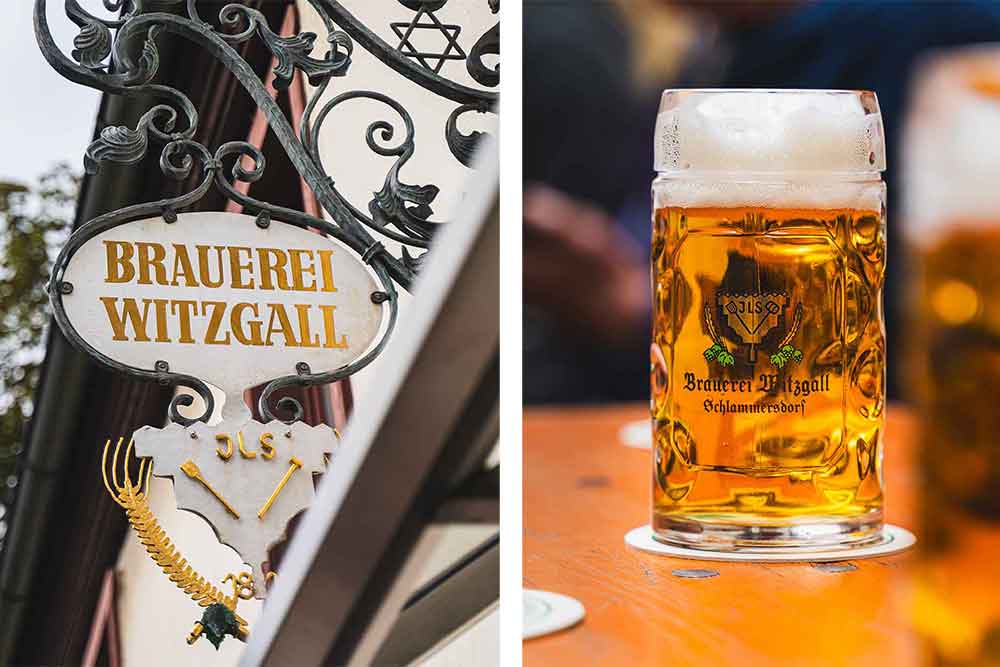
Photography courtesy of Magic Muncie, Social Media Manager, Hop Culture and Untappd
About a twenty-minute drive or a one-hour train ride south of Bamberg, Brauerei Witzgall came highly recommended by Frank Trosset, the former co-founder of Aslan Brewing in Bellingham, Washington, who had lived in Franconia for almost a year.
He brewed and lived in a small, sixth-generation family-run brewery in a tiny village of two hundred people, often drinking his way across Upper Bavaria.
“Franconian lager is the perfect bisection of drinkability and intrigue,” Vosset told us for a previous article by Pachmayer, who reported:
“The way Trosset sees it, there is a lot of highly drinkable lager in the world, but it lacks a real intrigue. That intrigue, he says, primarily comes down to the process of making the beer. Breweries in Franconia are most often open-fermenting the beer, and many are still using coolships for their lagers. Not every brewery uses these techniques, but Trosset says there’s an edge to the beers produced using these more rustic methods, as he puts it.”
Like those at Brauerei Witzgall, where Trosset recommends trying the landbier, a style that’s hard to define but roughly means “country beer,” or beer from the land (only available in bottles), and the vollbier, a sort of fuller, rustic lager that’s only available on draft. The latter is more highly rated (highest-ranked landbier on Untappd for the last two years), but according to brewmaster Matthias Witzgall, who stopped to chat with us, the vollbier sells better.
With a pub-like atmosphere inside, Brauerei Witzgall features a lovely beer garden in its side alley, anchored by a pear tree that grows to the height of the brewery.
Matthias told us the tree, which he used to climb as a kid, is over one hundred years old.
History permeates everything at Brauerei Witzgall.
Founded in 1811, Brauerei Witzgall remains a family-run operation. Matthias remembers rolling kegs and watching his uncle and dad in the brewery when he was only five years old.
Although Matthias thought he’d become his own person and not run the family business, it turns out, “I was pretty good at [making beer],” he told me.
We can agree. The Vollbier is absolutely phenomenal, pouring a crystal-clear gold with more body and taste than a helles. The rustic lager had a distinct hop presence, with a hint of Noble hop slickness and spiciness that complemented the fuller, malty body. We might call this more like the West Coast IPAs of rustic land lagers, if we can be so bold.
According to Kerschbaumer, when he called to set up our visit, the brewery was very confused. Groups of Americans just never visit here. And that’s a shame.
If you have time, consider visiting Brauerei Witzgall.
Baumwipfelpfad Ebrach (Treetop Path)
Radstein 2, 96157 Ebrach, Germany
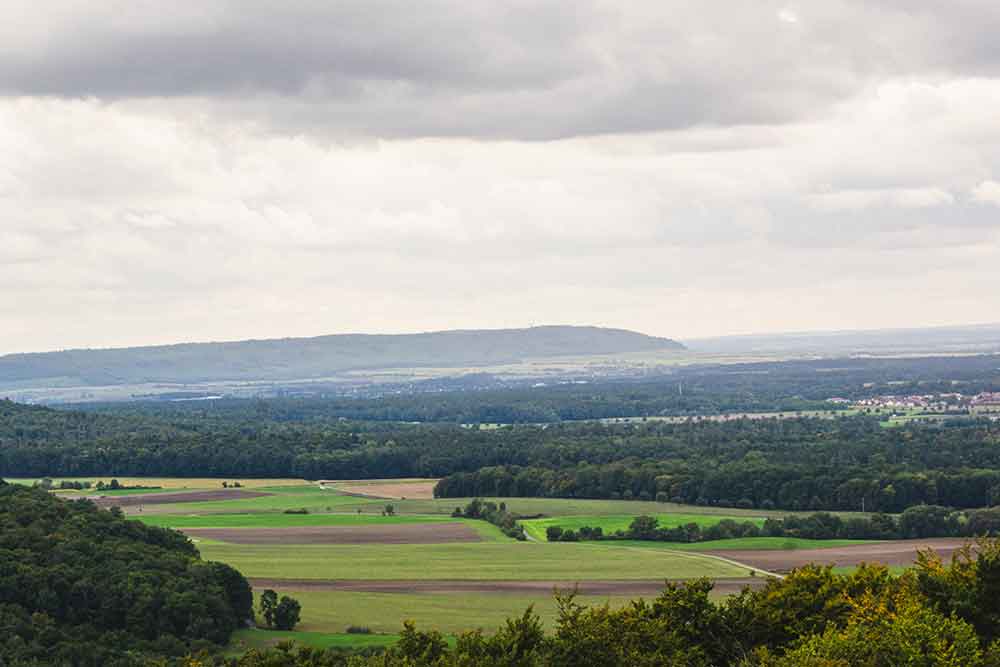
Photography courtesy of Magic Muncie, Social Media Manager, Hop Culture and Untappd
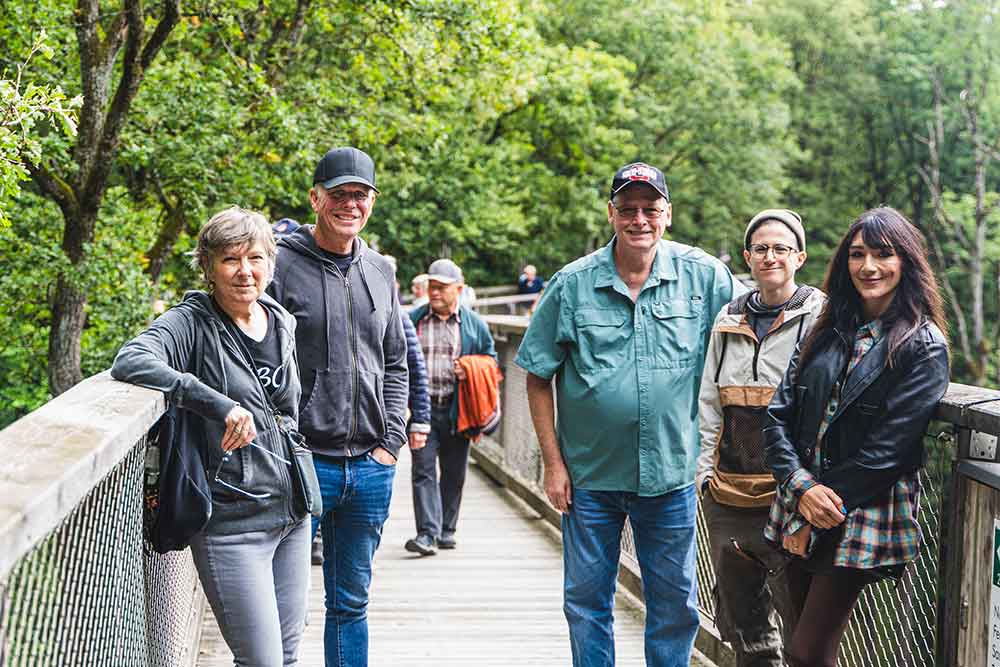
Photography courtesy of Magic Muncie, Social Media Manager, Hop Culture and Untappd
Looking for a break from beer. Gasp! A 1,150-meter-long walk along wooden platforms amongst the tops of the trees, Baumwipfelpfad Ebrach, offers a great outdoor detour from drinking.
At the center, you’ll find a 42-meter-high observation tower that takes you high above the trees, offering 360-degree views of the countryside.
Made entirely of wood, the paths wind upwards, gradually getting higher and higher until you’re above the treeline. The views are breathtaking and the climb is gentle, making it suitable for all fitness levels.
Take an hour or two to admire the Bavarian forests and countryside. We promise, you’ll get thirsty enough to be ready for another beer afterwards.
Brauerei-Gasthof “Zum Grünen Baum” Bayer Theinheim
Schulterbachstraße 15, 96181 Rauhenebrach, Germany
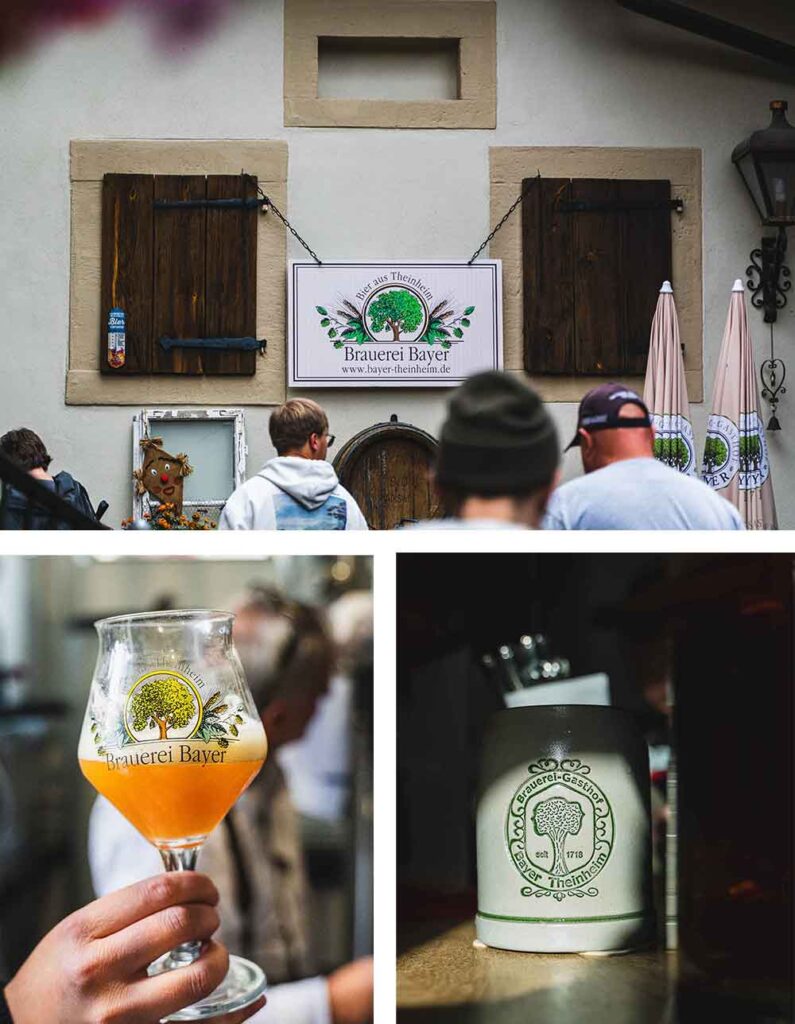
Photography courtesy of Magic Muncie, Social Media Manager, Hop Culture and Untappd
For one of our favorite landbiers of the entire trip, head to Brauerei-Gasthof “Zum Grünen Baum” Bayer Theinheim (aka Brauerei Bayer), a thirty-minute drive, an hour and a half train ride, or an hour-and-forty-five-minute bike ride west of Bamberg.
Helmed by master brewer Stefanie Bayer, Brauerei Bayer is one of the smallest breweries in Franconia, a region in northern Bavaria that boasts its own distinct culture, cuisine, dialect, and even beer styles (hence: landbier and vollbier). Consider that Franconia is to Bavaria as Scotland is to the U.K., a distinct place with its own identity within a larger amalgamated region.
And the family-run brewery, owned by the Bayers since 1718, proudly keeps things local, sourcing pilsner and Munich malt from Bamberg and hops from Hallertau and Spalt.
Brewing runs in Stefanie’s blood. Her grandad was the last brewmaster, while her uncle also brews, and her dad, Michael Bayer, owns the brewery but helms the kitchen. Since she was five years old, Stefanie has helped out in the restaurant and brewery, cleaning glasses and tapping kegs. When she grew up, Stefanie eventually earned her bachelor’s in brewing at Doemens Academy in Munich, taking over the reins.
The small 40-hectoliter brewery makes about 2,500 to 3,000 hectoliters a year, focusing mainly on just two types of beer—landbier and knörzla, a sort of rustic amber lager whose name roughly translates to a couple of things like “from the woods” or the Franconian word for the end of the bread. Which, with a malt bill of Pilsner, Munich, and caramel malt, is pretty much what this beer tastes like.
But much to the excitement of our group, Brauerie Bayer also has a dedicated sour program, pretty rare for that area, thanks to Stefanie’s uncle, who developed a love for sour beer while traveling in Belgium. They also make special seasonal beers, such as a dark doppelbock for Christmas and a summer ale in the warmer months.
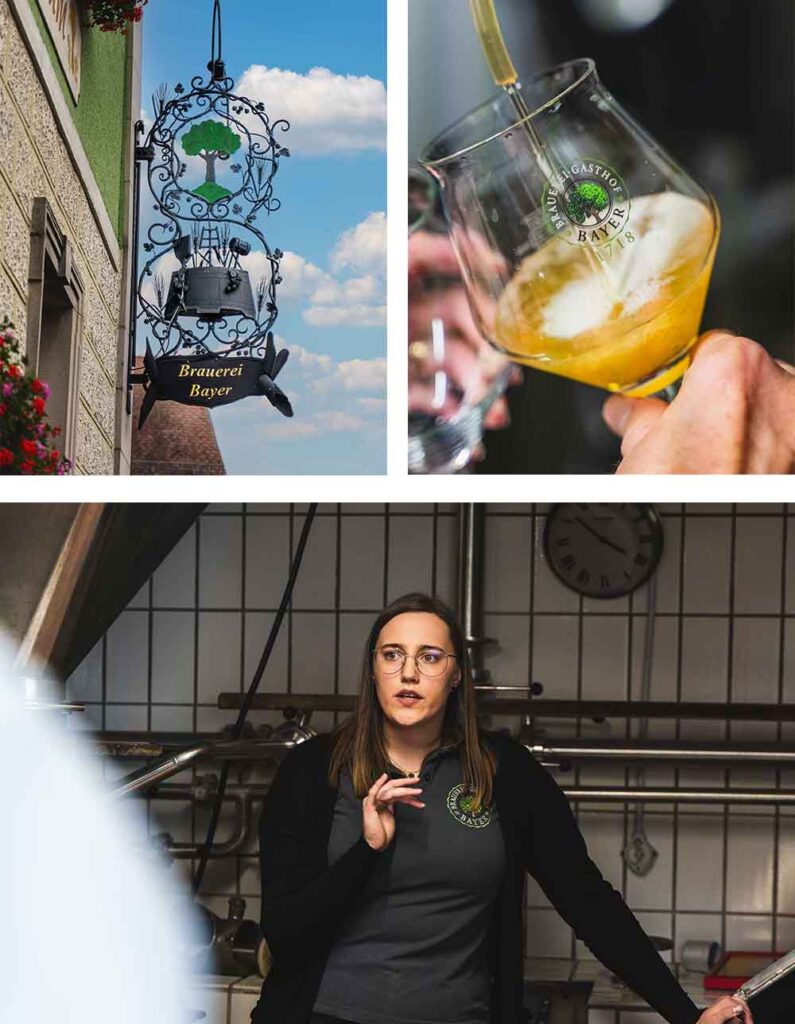
Photography courtesy of Magic Muncie, Social Media Manager, Hop Culture and Untappd
Somewhat coincidentally, while we visited, Hop Culture Social Media Manager, Magic Muncie, struck up a conversation with a guy wearing an Other Half tee at the table next to ours.
Turns out Pachmayer had actually interviewed Jose Santos Caro for his own piece on “Everything You Need to Know About Visiting Franconia’s Rich Beer Scene.”
Santos Caro, who estimates he’s visited 300 of the 350 breweries in Franconia, considers Brauerie Bayer in his top ten. He counts himself a regular here and couldn’t have been more stoked that we were visiting. He thinks the landbier is top-notch here, giving it effusive praise over our conversation.
Absolutely delicious, we crushed three or four of these ourselves from their beautiful mugs, making us feel like regulars, even if just for a few hours. Zippy with a whisper of underlying spiciness, the 4.7% ABV beer presented mostly clean malt, with nothing over the top.
“It’s very, very easy to drink,” Stefanie almost cautioned us.
To truly understand what landbier can be, you must try Brauerei Bayer’s version.
Putting Brauerei Bayer over the top is its excellent food, still passionately made by Stefanie’s dad. With a focus on fresh and local ingredients, Chef Michael incorporates items like Steigerwald asparagus and wild boar into his seasonal Franconian dishes.
“You can really taste the love in their food,” proclaimed Judy Sees, one of the Untappd enthusiasts on the trip.
The longer we sat at Brauerei Bayer, the louder it got, as more and more locals crowded into the booths around us.
“I just loved listening to those guys behind us,” said Frank Sees, Judy’s other half. “You could just tell they were having a good time.”
And so did we.
Wirtshaus Graser
Schranne 1, 96049 Bamberg, Germany
If you’re looking for one more beer to wrap up your epic Bavarian adventures, we suggest Wirtshaus Graser, a recommendation from Benedikt Steger, the founder of one of Bamberg’s best new craft breweries, Blech.Brut.
We met him there for drinks, where he explained to us that Schlenkerla had taken over the old Graser brewery. The beers now produced at the tavern come from Schlenkerla, but they’re styles new to the brewery, i.e., without the smoke.
And yes, if you’re wondering, Schlenkerla makes a pretty mean landbier and kellerbier, too.
It doesn’t hurt that this pub sits right on the Regnitz River, whose series of small waterfalls underneath Bamberg’s bridges make for one idyllic sunset sip.
Sit, drink, and reflect on an amazing five days in Bavaria. Realize that you’ve only scratched the surface and start planning your trip to return next year.
Interested in hearing when we curate our next trip? Sign up here to get updates first.

